Click here to go to Susan’s Main Page with the Finished Project (next)
Click here to go to Susan’s Historical Context Page
Click here to go to Susan’s Fashion History Page

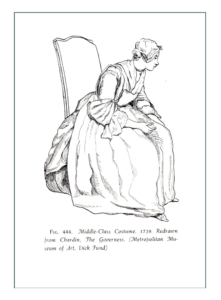
 Two Worlds Merge
Two Worlds Merge
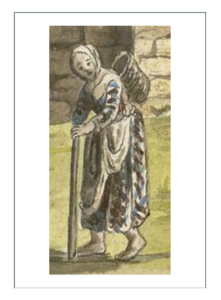
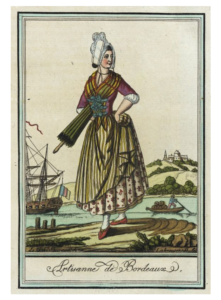
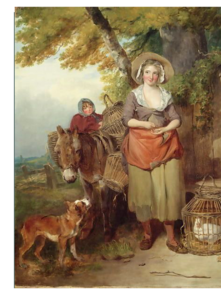
(above): 1797 French farm girl, 1796 Colonial farm girl, 1772 Highland weaver’s clothing was based on the same undergarments and concepts: local weaves, earthy colors, calf high skirts, comfortable bodices with scarves, headwear, apron used for function, and cap
What we take from Celtic 1740’s, “Outlander”, & Colonial 1770’s Fashion for this Design
The overriding concept here was “did Highlander women know about and/or want to wear European fashion?” Being next door neighbors and in conflict with the English, the gut reaction would be “no, they wanted to do their own thing and respect tradition, support local economy, and be self-sufficient” based on what we understand as their historical culture.
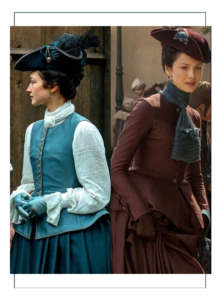
In reality, and as extant garments and portraits attest, Celtic women from Highlands (and especially the Lowlands who were in sync with the Europeans due to their economic dependencies) embraced European fashion ideals AS THEY EVOLVED. This is most likely due to the fact they had for most of their history been allied with France, who during the 30 years we are discussing, led worldwide fashion.
It is a bit difficult to make comparisons, as mostly portraits were made with carefully selected and special clothing. From them we can tell what the wearer VALUED (such as the hair of the day, fabric, lace, or detail). Because there were no cameras, we can best tell by writings (descriptions and satires, especially the cartoons of the French media who focused on fashion) or extant garments, and of course people saved their best ones.
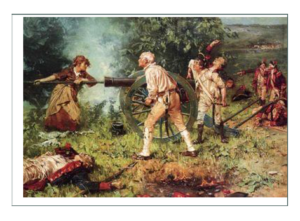
So we have a fairly good understanding of what was important to them. To determine what was actual and daily, we depend on analysis. When you get down to it, and because fashion is as personal now as it was then, it’s really just a good guess.
Here are what we can tell are the commonalities to draw from for our design:
1. Undergarments
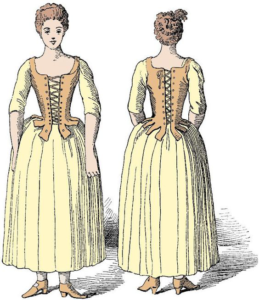
1745-75 were much the same, with the exception of stays. Even stays, however, had flexibility and choice in design and fit during those 30 years. A woman of Scotland 1745 very logically might wear her same stays throughout if they were comfy and fit well.
They all had:
Shift – the earlier type with 3/4 sleeves, durable mid-weight linen, angled gores, and optional bodice ties; the narrower fit through the bust to reduce volume
Stays – 6 pieced, front and/or back lacing, handmade, predominantly yellow, pink, or brown, fully boned, with specific design to create the inverted cone shape (not to shape the body). Leather or linen (silk brocade for high class)
Inner Petticoat (for low class rural peasants, this was sometimes the outer petticoat too) – linen. Cotton later and for wealthy, basic, solid earth colors or natural
Wool stockings – knitted (also knitted arm gauntlets for rural and working. Gloves for high class)
Period shoes – pointed to rounded toe, buckled, strapped, or tied across the instep, leather
Mobcap – small, no lappets, not ornamented, linen (cotton for high class). Sheers and ruffles; pleats later depictions
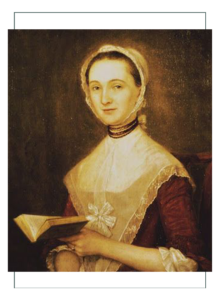
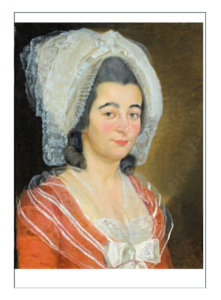
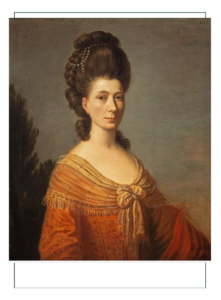
2. Outer Garments
What you saw on the outside of the ensemble was specific to location and occupation. In Scotland, these were local weaves and plaids with earth colors; in the Colonies, it depended what they could afford or get; a great mix of natural, local weaves and patterns plus a whole world of imports (notably cottons and silks).
The rest is open to interpretation although to summarize we would have to say to best summarily represent the 30 year period and both countries:
Robe a l’anglaise – short as a jacket or long. Linen (silk for high class) with linen lining, boning, (cotton or silk lining for high class); caraco or short gown (robe) depending on class, location, and occupation/activity
Outer Petticoat – match or coordinate with Robe also linen. Quilted and with binding hem (silk, highly ornamented w/fancy work, ruffles, or trims for upper classes or Court)
Bum roll – (paniers for high class, with skirt adjustment) The “sausage tube” type works with both early and late depictions instead of the hoop, oblong hoop, or panier for working women
If we had to pick just 3 ensembles, one each for lower/working class, middle class (dress up), and upper class (not Court) that summarized all above for the 3 locations, we find these examples of Robe a l’anglaise ensembles.
They feature the fabrics and details: linen, cotton chintz, silk fabrics. They have the neckline and construction the same; the same silhouette. What differs were the rules of hair and apron, and ornament.
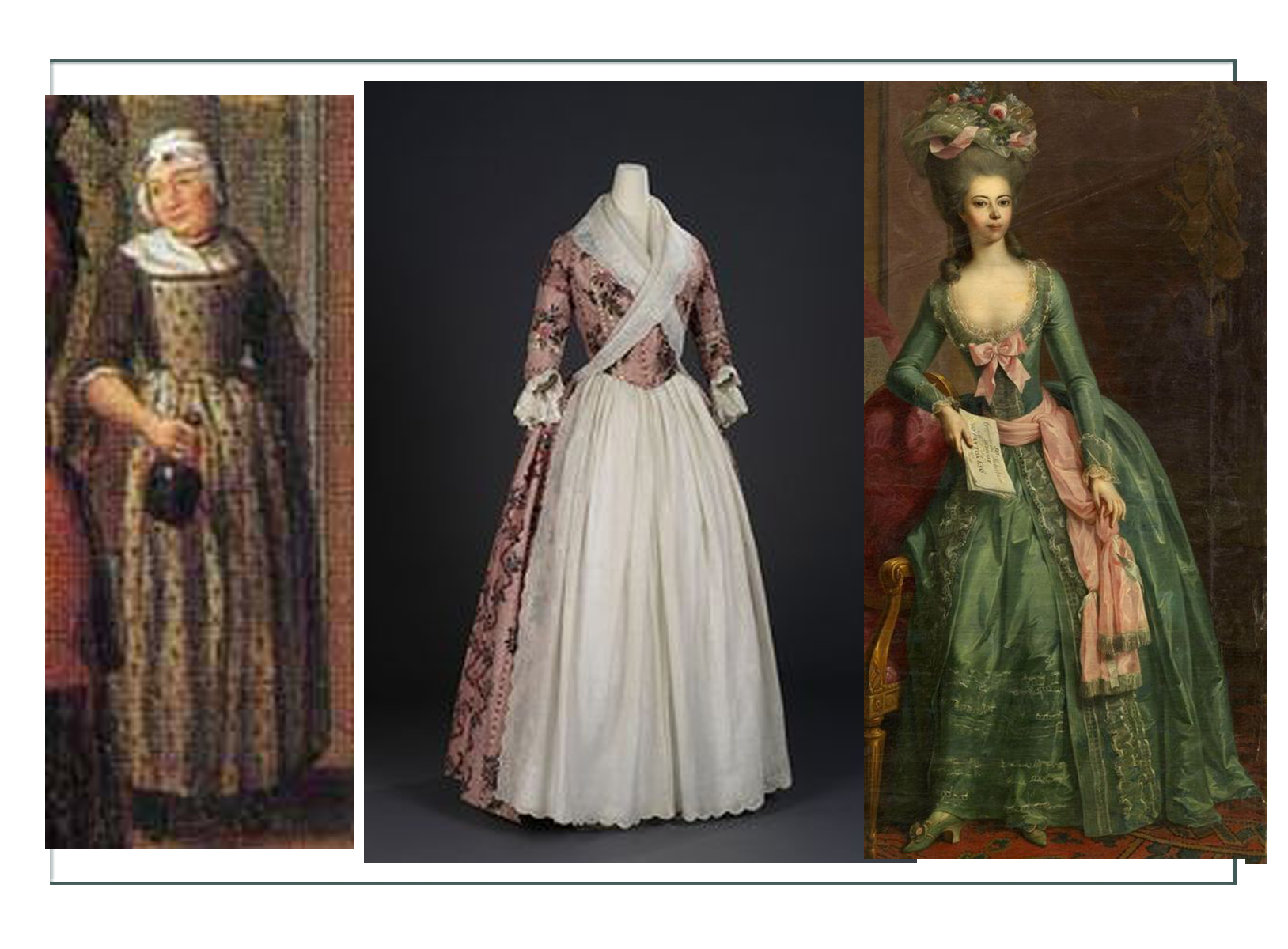

Click here to go to the General History of Nursing & Colonial Nursing first
Character & Healing – Specifics for Character & Costuming
To understand the character of Claire, and of Susan, we need to look at their place in society and in particular for costuming the 18th century: social status and activities.
Susan is a real modern day healer, trained and experienced in the most current ways possible. Her character, like “Outlander’s” Claire, has knowledge beyond that of the ordinary healer of the mid- 18th century. Like Claire, however, she must only work with methods, techniques, materials, chemicals, available to her at the time of the depiction. She also must meet with the historical cultural attitudes, biases, and social limitations of the day.
The first limitation is being female. While the main woman of the house, or the “wise woman” of a village was almost always the respected healer in a village or with a clan, she was also viewed suspiciously. The better she was at healing; the more the suspicion. Someone like Claire bringing surgical skills would be especially under suspicion, since surgery at the time was considered a trained physicians job.
The second limitation would be that the better she was at the job, the less she would be able to do openly without danger to herself. The old attitudes towards witchcraft still existing in the 18th century, especially if supposedly knowledgable practitioners had no idea what she was doing or how she was being successful.
As we review the history of healing however, at the time these “surgeons” were not really hands on practitioners, but more of the type as we would think of an astronomer or physicist; dealing with theory and calculation and the study of the body and healing more than a hands on approach.
This would make a hands on healer’s success of high merit to those who needed her, but, of high suspicion of those supposedly trained to do the job better, even if they couldn’t.
How that Relates to Costuming & Characterization
In “Outlander”, Claire brought back from the future in her pockets as much modern medicine as she could. Throughout the entire story, she was always looking out for medicinal herbs and stocking them. A very interesting aspect of staging in the movie are the changing vials and containers she had to do this, and the spaces (rooms, apothecary shops, etc.) depicted throughout.
Deceptively Feminine
To avoid unwanted suspicion or attention, Susan’s character would need to appear to be subtle and not attract notice. She would want to blend in with the locals – whereever she was, and would change like a chameleon to do so, given her financial situation and access to dress and goods.
She would, even while carrying out complex male dominated activities such as surgery, need to dress in the most feminine style of the day. For 1745-1775, that means the standard “sacque” dress as modified for the geographical region, made from locally obtained materials and notions.
Lots of Storage
She would need to hide things that she should not know about (needles, syringes, etc.) or that were considered “taboo” such as certain herbs. The chatelaine in particular was worn by women through history, and keeping basic domestic housekeeping tools such as keys, scissors, as well as basic medical equipment out in the open would be acceptable. The rest should be in pockets.
Changes from the Standard of the Day
Susan’s character would need to be in the most basic garments that everyone was wearing at the time (as defined in the section on “Fashion History” on preceding pages as the basic robe, petticoat, bum roll, and accesories). Blending in would be the key, so it would need to be natural to the geographic location – be it Scotland Highland or the southern Colonies of the New World.
She would not be dressed as a healer, but would have more pockets and “secrets” such as a chatelaine with secret pockets, inside pocket for carrying herbs, or an accessory bag for carrying plants. As illustrated in the “Outlander” shows, everything would need to be able to be converted to function; e.g. petticoat for bandages, rump for a fire, headwrap for a tourneqet.
This would be nothing outside of normal every day dress for a woman of the era, but the type of fabric, texture, and method of wrapping might change from normal. Pockets should be the largest possible, and things like aprons and jackets should have the ability to tuck and become carrying bags.

Susan is somewhat divided between a 1745 “in Scotland on the farm” depiction and a 1765-75 Colonial depiction. This is understandable give the “Outlander” storyline starts in 1745 in Scotland and ends in about 1783 after America wins its independence from England.
A lot happens in between, and while she may want to do both at some point, right now she wants only one depiction. What is consistent between both ideas however is:
- Rural interpretation
- Middle Class, with enough wealth for multiple outfits, but not many.
- Beautiful rich colors and reproduction fabrics; possible tartan of her own clan, or fabrics as per her samples
- Shortgown or caraco (jacket) with petticoat; front lacing preferred
- Date accurate design of length or petticoat, bum roll, fit of jacket
- Period accurate shoes and accessories
- Simple, easy to dress, easy to wear, comfortable
- While Claire lived in cool, wet climates, Susan lives in a hot one. Where the ensemble(s) will be worn is key
- She wants inner pockets.
- Nothing fancy. Let the design, fit, and fabrics “speak” for themselves
- Feature the feminine figure and silhouette of the time through proper stays and foundation garments well fitted so it looks right intuitively to onlookers

If we combine the research on the fashion of the day, location, access, affordability, and preferences of Susan for her character, design can be summarized as:
- Basic linen shift that will be worn with all items and will show through. 3/4 higher necked version of the earlier time period of choice (1740-1780)(as opposed to the wide bodied very low necked and hidden shift of the later dates);
- Interchangeable pieces such as gauntlets and shawl that work with all ensembles;
- Inner petticoat basic linen. Outer petticoat of something special but of very simple construction (no quilting or embroidery; let the fabric and structure and fit make the statement);
- Jacket not short gown, fitted and of coordinating fabric (wool to match wool petticoat, or floral to match plain linen petticoat);
- Minimal ornament with no fuss;
- Put the time into pockets and fit;
- Large apron for tucking in and using. Coordinate those fabrics too;
- Length of petticoats correct for working woman; rump appropriate to date selection;
- Correct but worn and used looking period reproduction shoes and stockings since they will show;
- Mobcap correct to occupation, status, and location;
- Optional accessories knit or otherwise.
- Natural dye colors (or import from India block print in case of florals)
- Textiles available to location
- Working ensemble. Strong, Tough (big apron), short petticoats
- Fun accents: knit accessories, worn shoes, dirty apron, etc.
- Must have a mobcap! Working woman’s though

Modern Interpreters & Re-Enactors
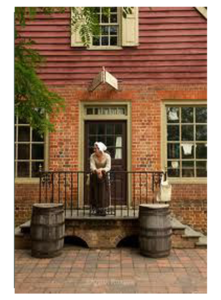
There have been 1000’s of women re-enacting the Revolutionary War and Colonial Eras in America through the years. Colonial Williamsburg, a working historic site, itself employes 1000’s each year, in various degrees of historically accurate costumes.
We can take inspiration from the hard work others have already done to depict the 1770’s for Colonial garments; in fact, the shops at Williamsburg are REAL sources from which to buy reproduction historically correct fabrics, pins, bonnets, and complete garment ensembles! They have their own lines of fabric and notions, and is the source for your pomades and hair lifts.
Being inundated with formal painted portraits of Royals and Nobles, we needed to find more inspiration that was accurate AND OBTAINABLE today of women in the class status of healers – like Susan. Here are just a few favorites, notably from Colonial Williamsburg, which are our designer’s selections of real modern period correct 1770’s garments to draw inspiration from:

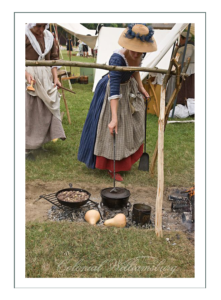
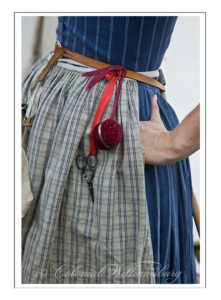
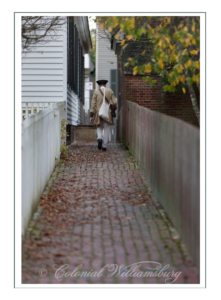
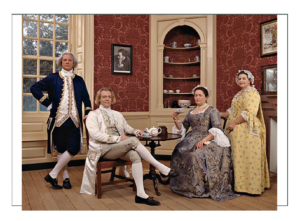
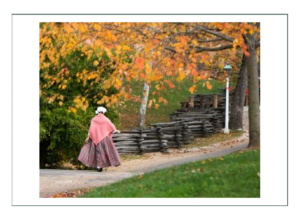
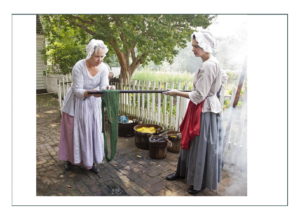
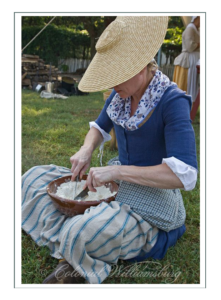
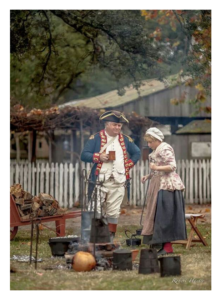
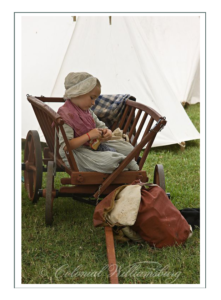
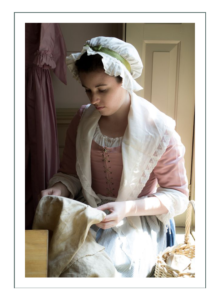
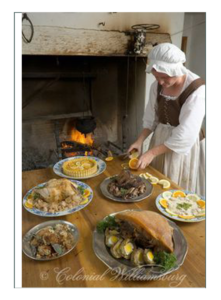
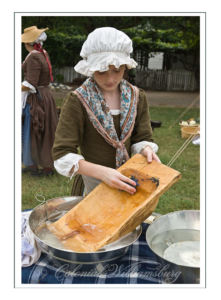
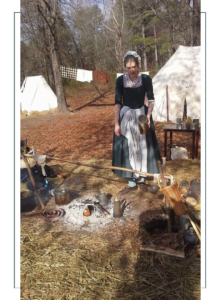
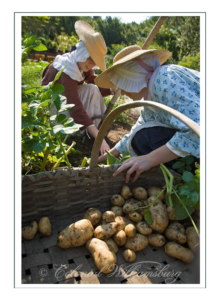
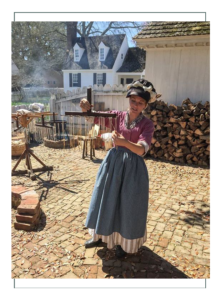
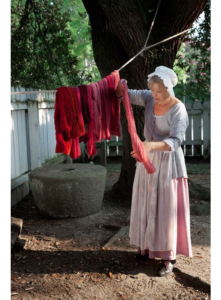
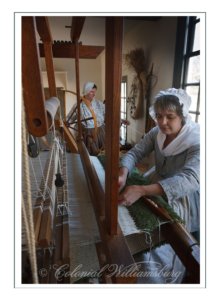
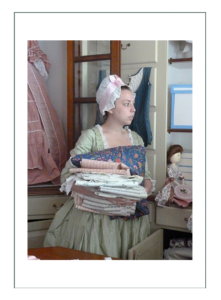
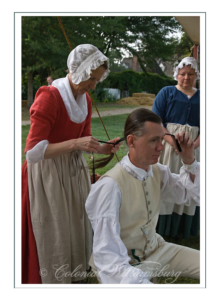
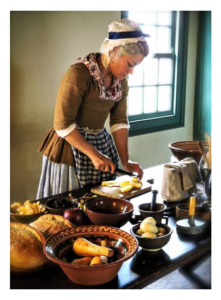
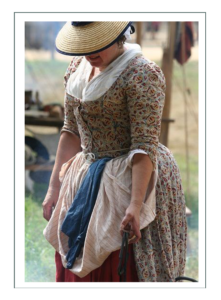
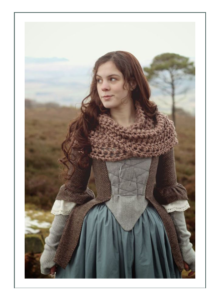
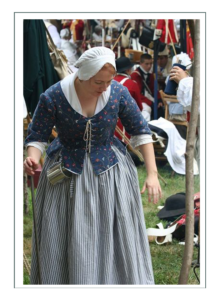
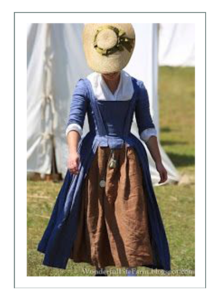
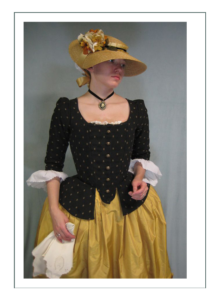
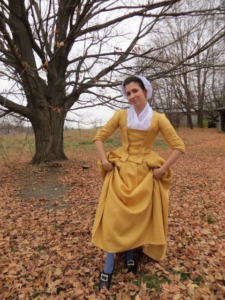

Susan’s searches for the type of image she would like to project, the comfort for her warm climate, what she has seen and liked, and what she has researched she would like to do.
Note her preferences are divided between 3 concepts:
- plaid wool petticoat with solid bodice and rich textile accessories typical of the mid 1740’s highlands (and as illustrated by Claire in the first 2 seasons of the series)
- solid colored (blue preferred) linen petticoat with chintz floral, striped, floral with stripes, plaid, or textured bodice (as shown by Brianna in Season 4 among others)
- solid colored top and bottom; possibly vest and petticoat with undersleeve (as Claire wears when she goes back 20 years later in Season 3)
- What??? No French Court extreme necklines and paniers with 36″ hair from Season 2??
She consistently points to:
- Short jacket – caraco
- front stomacher with lacing
- blue outer petticoat (or her own blue and gray tartan petticoat)
- large bum roll
- short, working woman length and shape
- no apron
- no mobcap (Claire never wears one which gets her in trouble)
- plain white linen fichu
- dark leather period correct shoes
- knit accessories
- blue/green, teal, gray, brown color schemes for 1740’s; blue/green with red or pink floral and brown accents for 1770’s

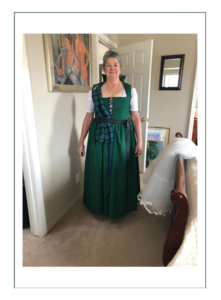
The Chintz Group
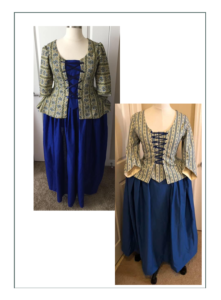
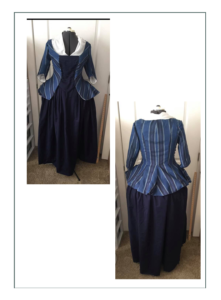
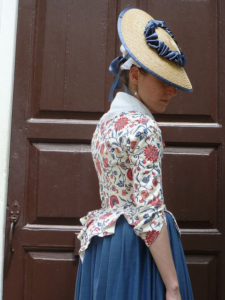
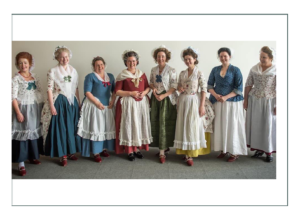
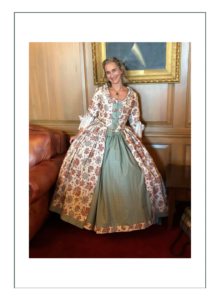
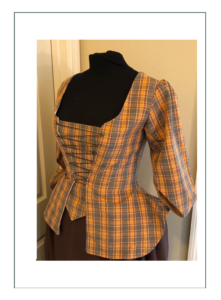
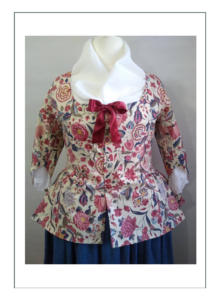
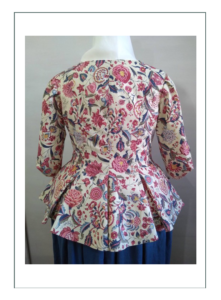
The Outlander Celts Group
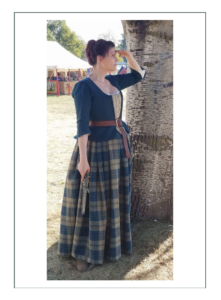
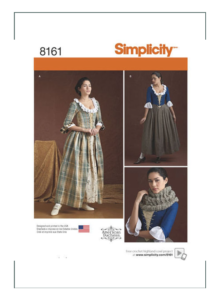
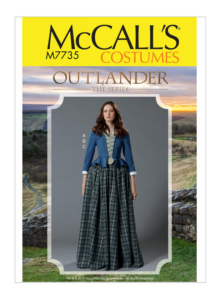
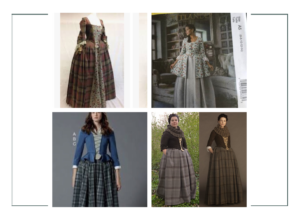
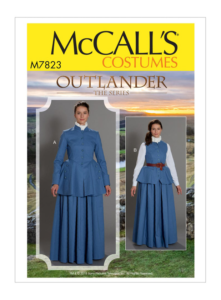
And Extras
(in conversation we note she is loving her herbal research and crewel work stomachers!)
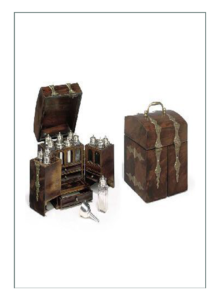
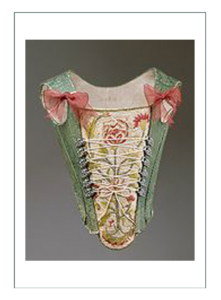
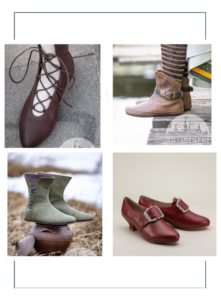
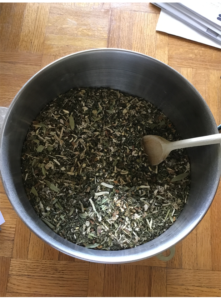
And the Tartans. She has purchased one called “Honour and Redemption” . It was registered in Scotland in 2017 as a “fashion” Tartan (for resale), and was designed and owned by the “Outlander” franchise:
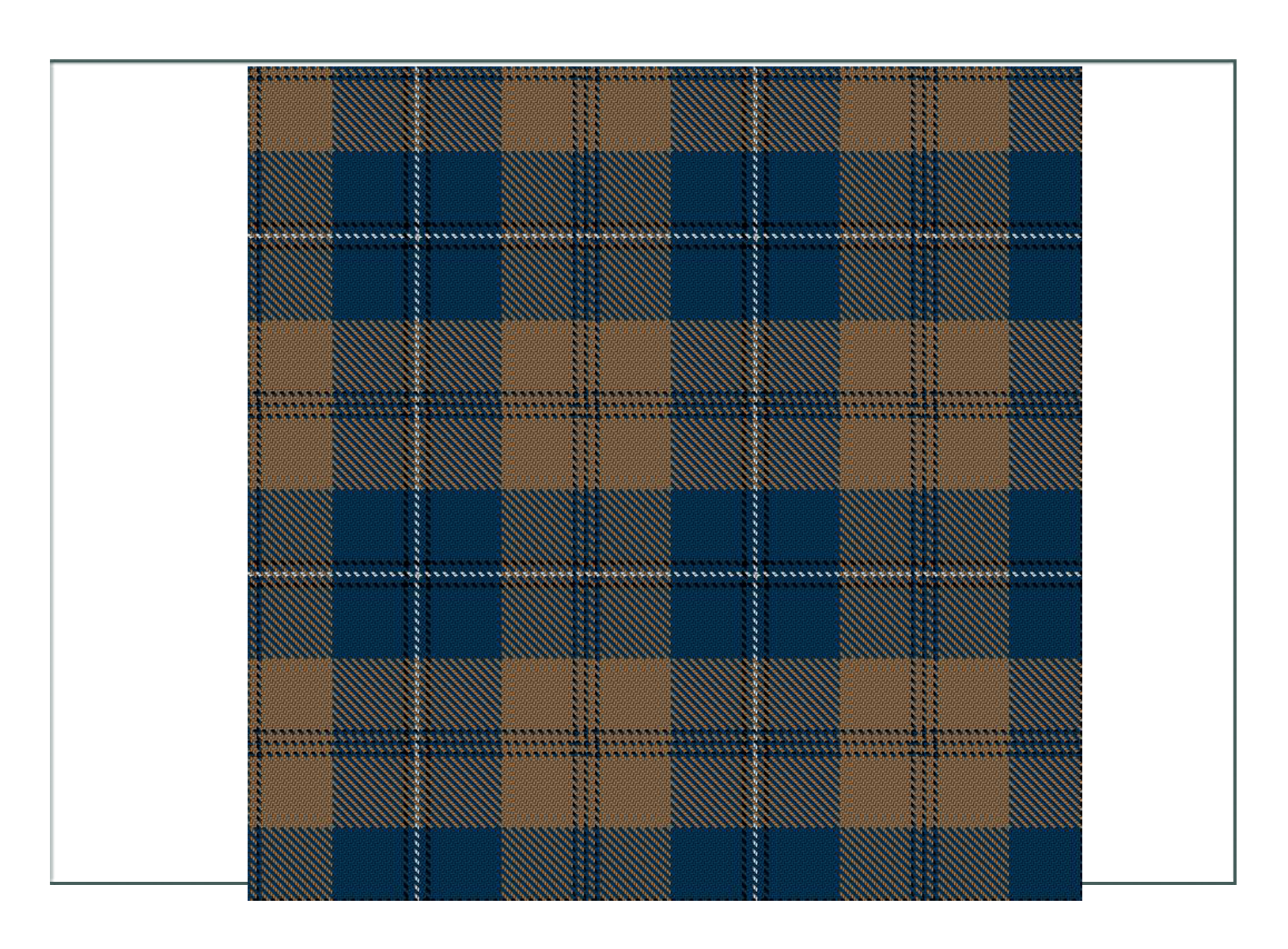
(This is her own McKey, MacKay, McKay Tartan!)
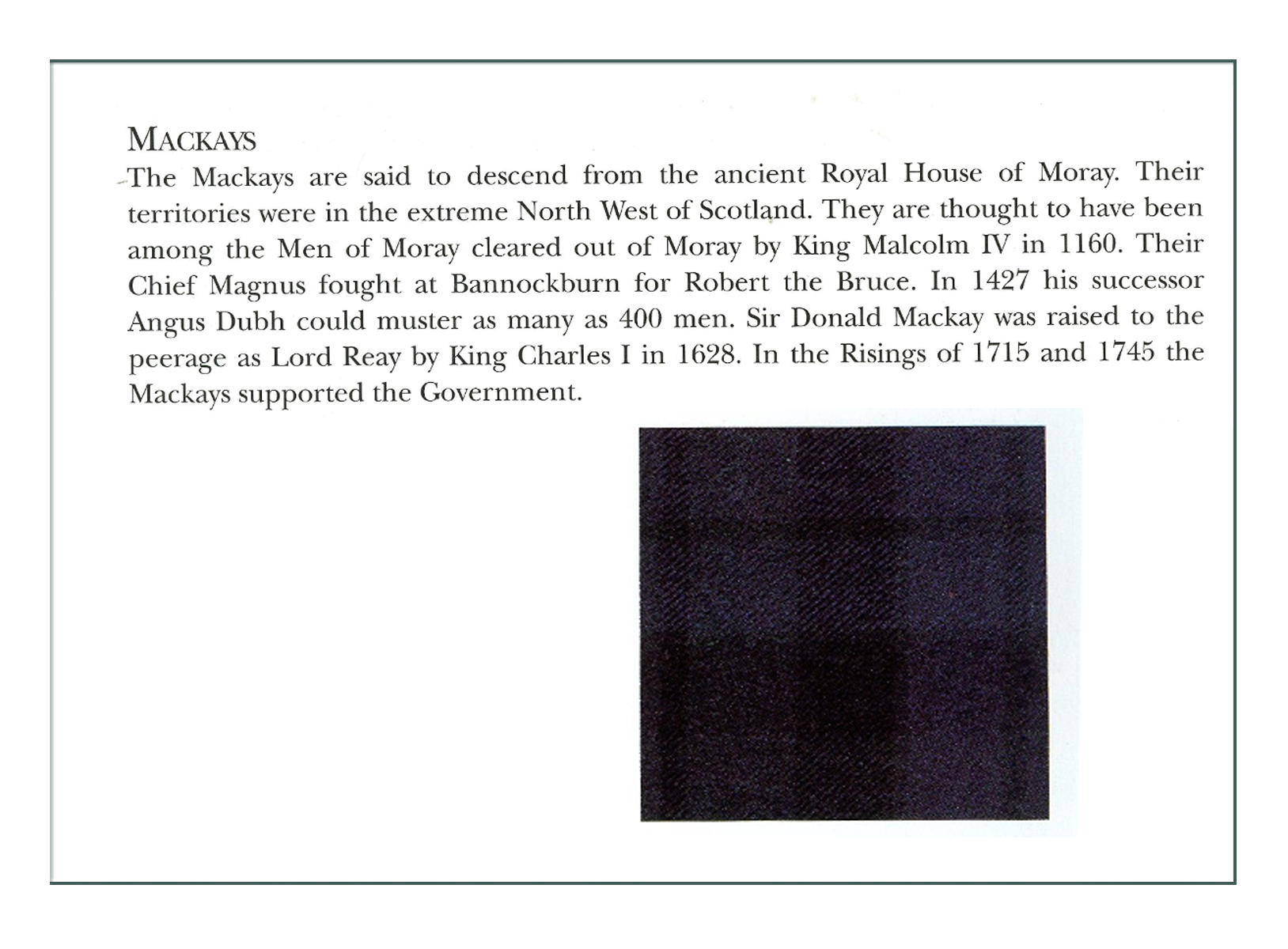
She has also purchased:
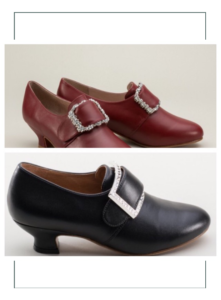
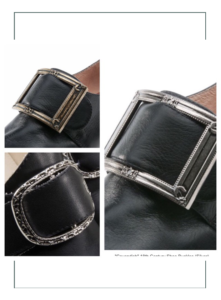
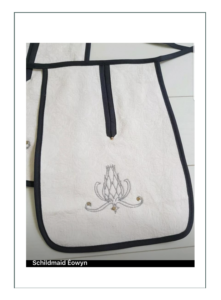
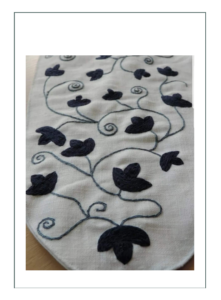
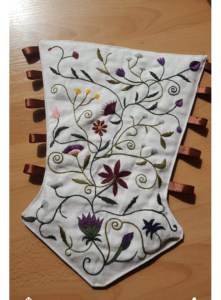
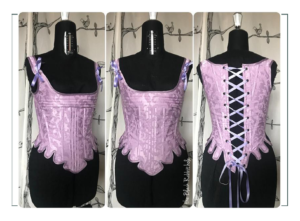
All of these things need to be integrated into the design

Goal – Intuitively Right & Good to Observers
Now, none of the above shows the UNDERGARMENTS, so it is good we discussed and summarized that at the top of this page. We have also already assisted Susan in fitting 1790 stays in lilac color lightly boned. If possible, we want her to be able to use those as well as new, more historically accurate stays of our design and build – custom fit to give good and comfortable support with the objective of the absolute correct silhouette.
We want Susan to be able to go to an event where there are others with great historical accuracy, and to hold her head high, if not to boast (what is more appropriate than a Highlander boast?!). Correct design and fit will not only be more comfortable for her for long days, but will allow people to intuitively, just feel that she “looks right”.
As far as construction, color, fabric, notions, ornament, and fit, we must depend on the prior pages of historical references to make final outer and inner garment designs and materials selections.
Based on our research and what is available to us within reasonable cost (of course Susan has cost limitations and a timeframe too!) and reasonable time and availability, we have narrowed down on her behalf wonderful options to build whichever direction (or both!) she chooses.
To quickly review, our summarized ensemble includes:
Shoes – (by customer) period correct black or brown leather with buckles
Over the Knee Stockings – wool (or cotton blend due to cost) with or w/o garters
Inner Petticoat – linen
Stays – Period correct (linen or silk, lined)
Shift – 3/4 fitted version with options (we already made this with neckline adjustable and basted sleeve ruffles designed to show at the elbow)
Mobcap – early smaller version, linen
Outer Petticoat – choice
Pockets – (by customer, she has)
Robe a l’anglaise – short or long, open (to see petticoat), laced with stomacher or closed with lacing strip or cross-button closure so it is very adjustable. Might be a shortgown instead. Completely open to choice after studying fabrics below.
NOTE: Susan has an ornate stomacher she may want to incorporate in this. She also has another seamstress building a correct plaid with her Clan Tartan skirt. We are not involved in this – BUT – choice of fabrics and colors may allow (if the robe is short or it’s a shorgown) to..
..coordinate between the two ensembles so the jacket or shortgown can be worn with both a linen and a tartan petticoat!
Quick NOTE: we need to build pockets, chatelaines, and ways to carry “stuff” for her healer character. Here are the leading ideas:
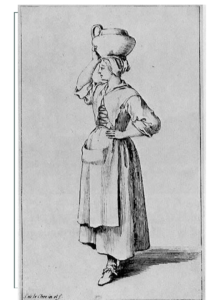
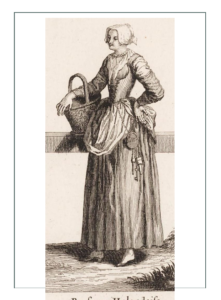
 Remember these? The colors, textures, and fabrics most consistent with working class women of the 18th century. These are period correct for low to high depictions.
Remember these? The colors, textures, and fabrics most consistent with working class women of the 18th century. These are period correct for low to high depictions.
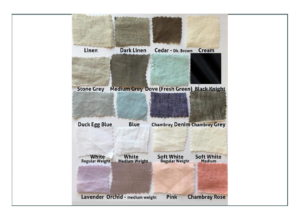
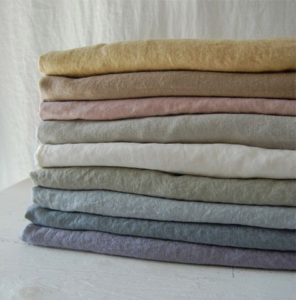
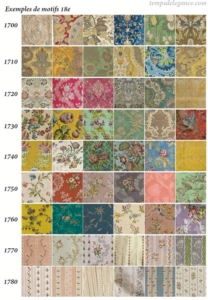
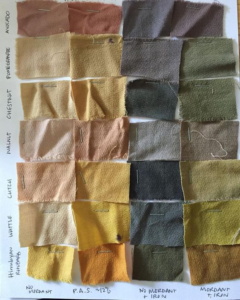
Historical examples:
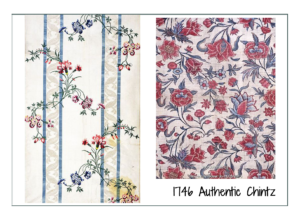
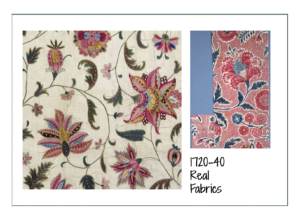
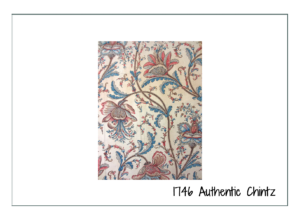
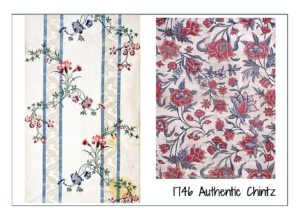
Susan’s desires are also divided between:
1745: wool, wovens, rich Scottish textiles, and garments suited to the Highlands. We’ll call it the “wool theme”.
1775: Chintz jacket or shortgown with linen as a middle class working woman would wear for “dress up”. We’ll call it the “cotton and linen theme”.
Both are suitable to the character, and both are suitable to the concept of travel (and time travel). The challenge is she only wants one ensemble right now, so it is our task to help her decide.
Fabrics consistent with Susan’s preferences that are currently available and reasonably priced for this project:
(note white linens, cottons, and muslins are not shown as they are all white and don’t look like much here. She’ll have to trust the samples mailed)
Wools
(Jacket, Robe, Skirt, Bodice, Apron, Mantle, Arisaid)
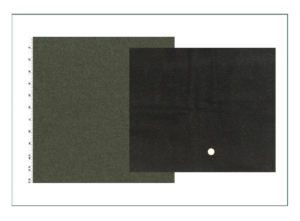
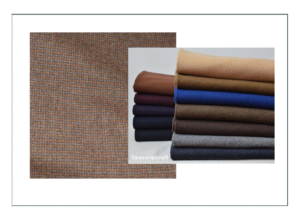
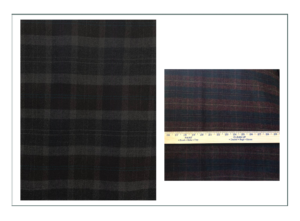
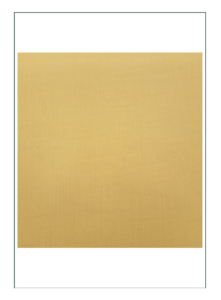
Cottons
(Jacket, Robe, Skirt, Bodice)
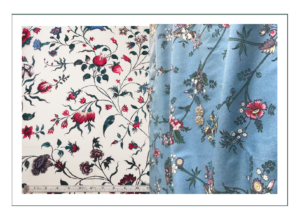
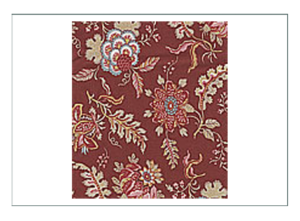
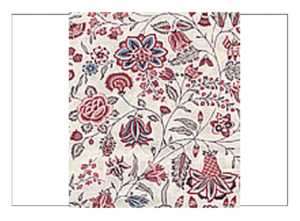
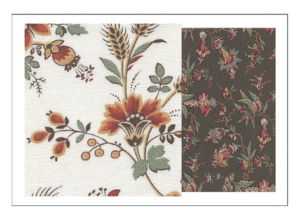
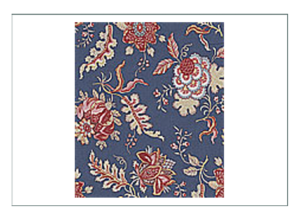
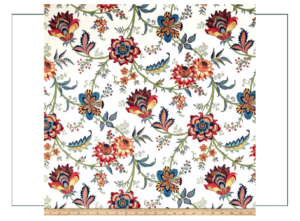
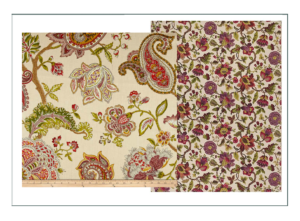
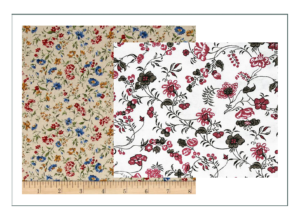
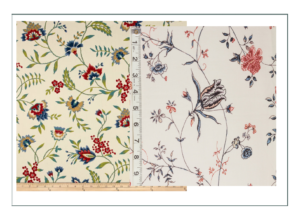
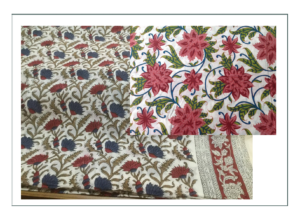
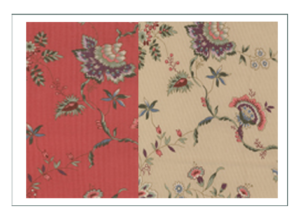
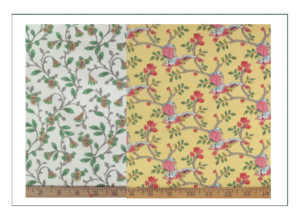
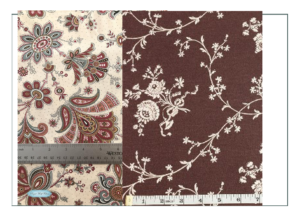
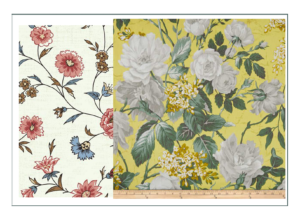
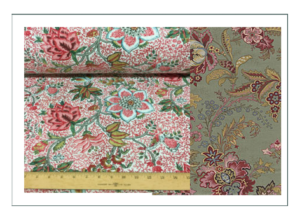
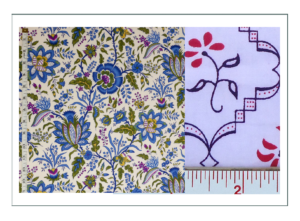
Linens
(Jacket, Skirt, Bodice, Robe, Petticoats, Apron)(Lightweight white or ivory for caps and fichus not shown. Refer to samples mailed)
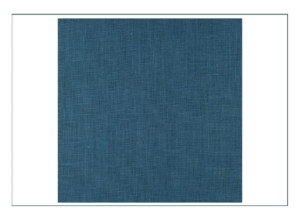
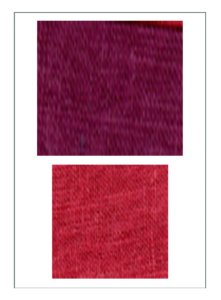
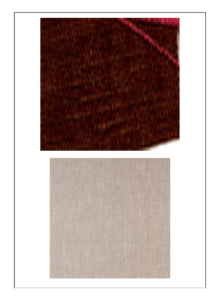
Silks/Brocades/Crewel
(Stomachers, Stays, Jacket, Bodice)
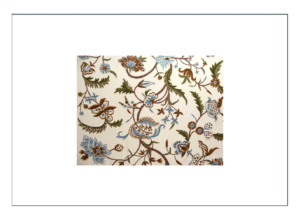
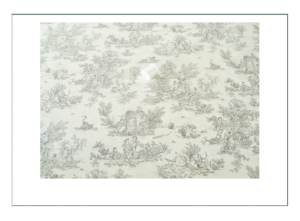
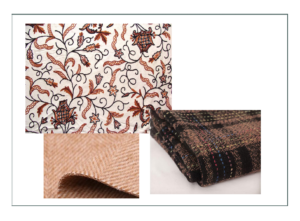
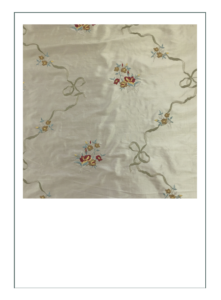
Homespun (Cotton weave)
(Apron, Headwear, Scarves – note the color of homespun has to be “read” from a distance like a Tartain; e.g. red and blue checks will look purple in the outfit. Trick is to have it match up close and far away, so subtleties in color blend do matter!)
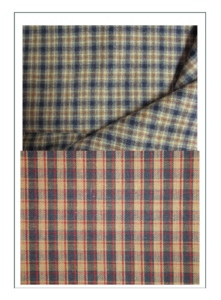
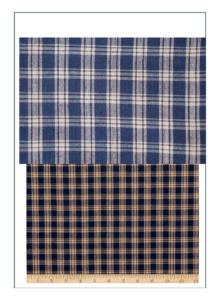
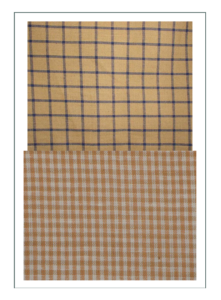
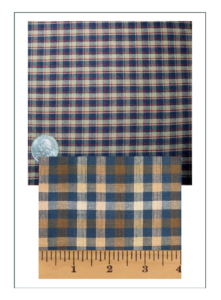
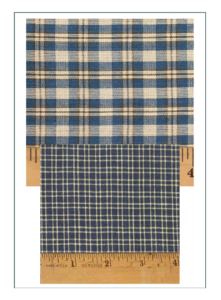
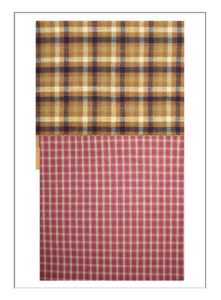
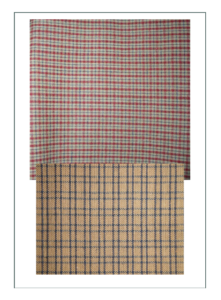
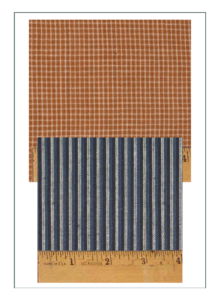
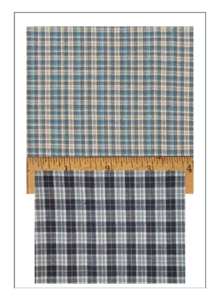
Or.. how about blending wools, cottons, and linens??
(Cotton, silk, linen blends in damasks and brocades)
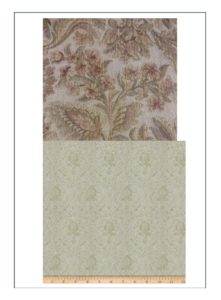
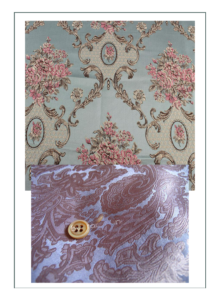
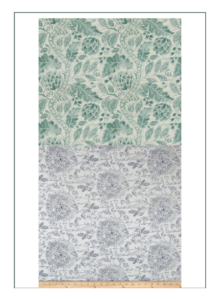
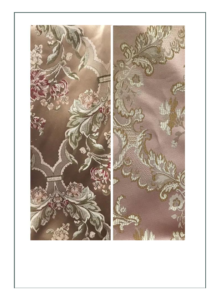
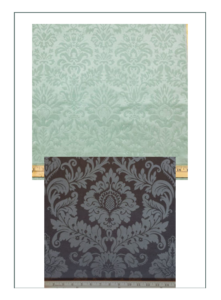
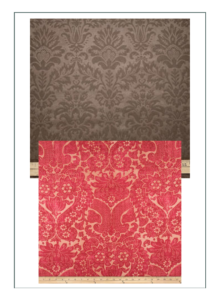

Lace
(Apron, Cap, Fichu)(For full lace aprons, we use vintage tablecloths and curtains! Lace by the yard is rarely wider than 7″, and those are of synthetic and modern fabrics or fabric backings. These are 100% cotton as would come out of Holland, England, France, or other European sources. They are for dress up Middle Class, or high class garments
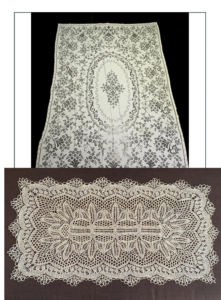
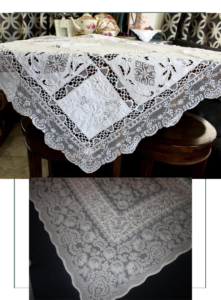
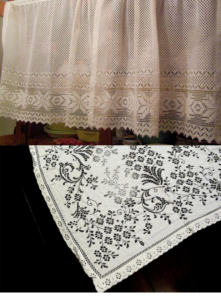
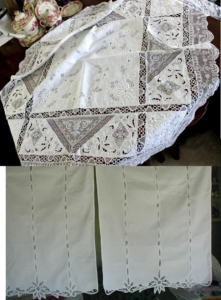
Designer’s Recommendations
Narrowing the Choices
For the Stays
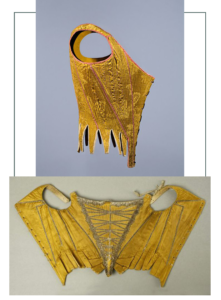
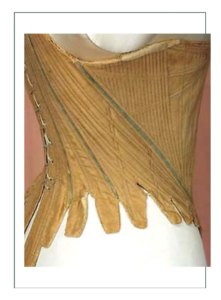
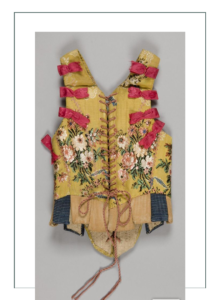
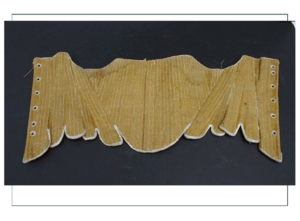
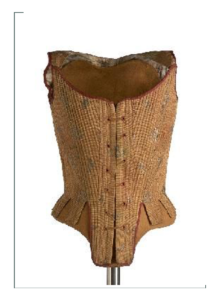
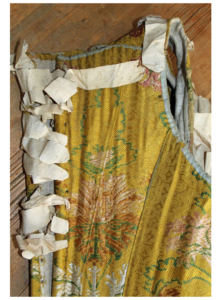
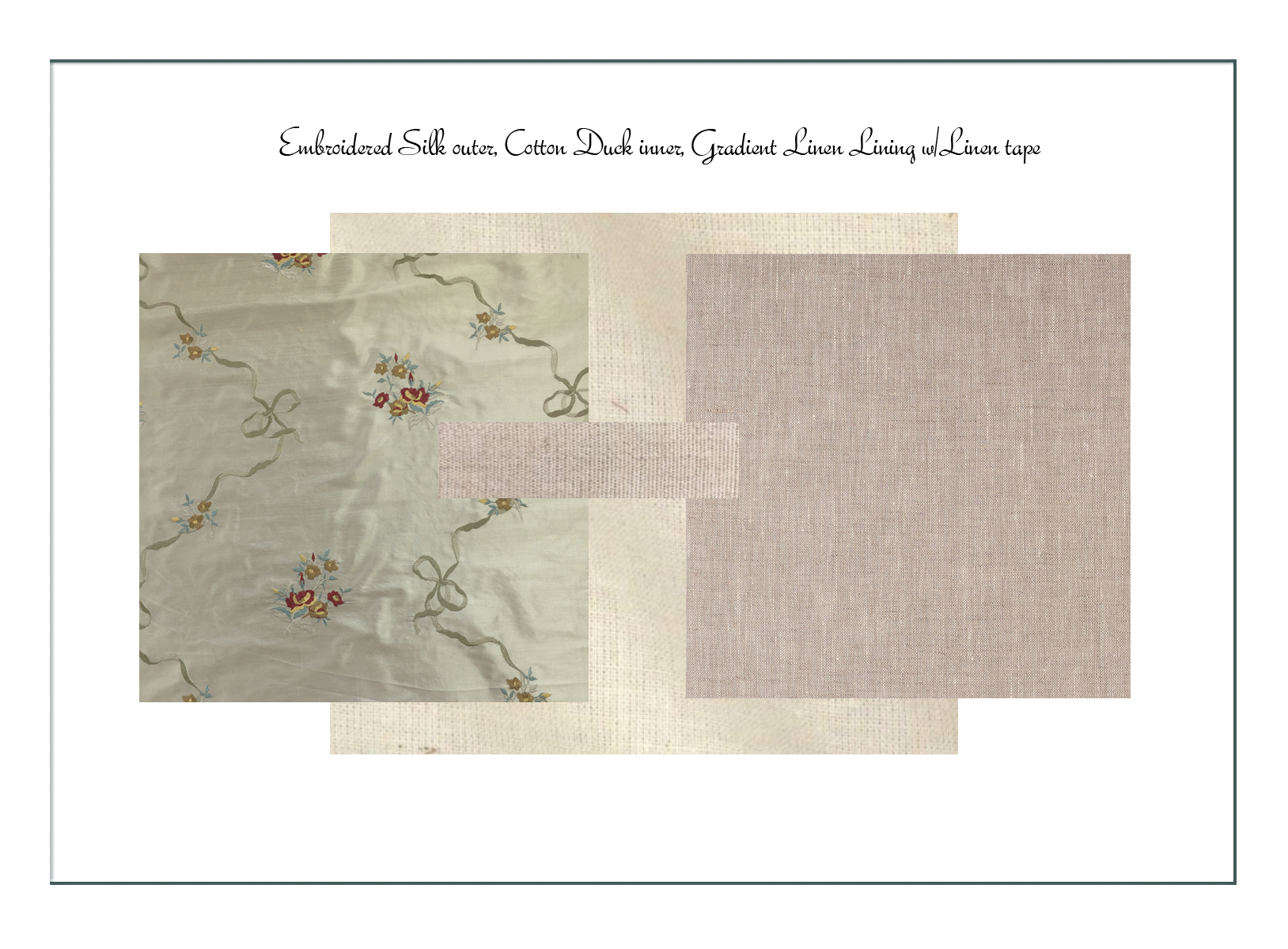
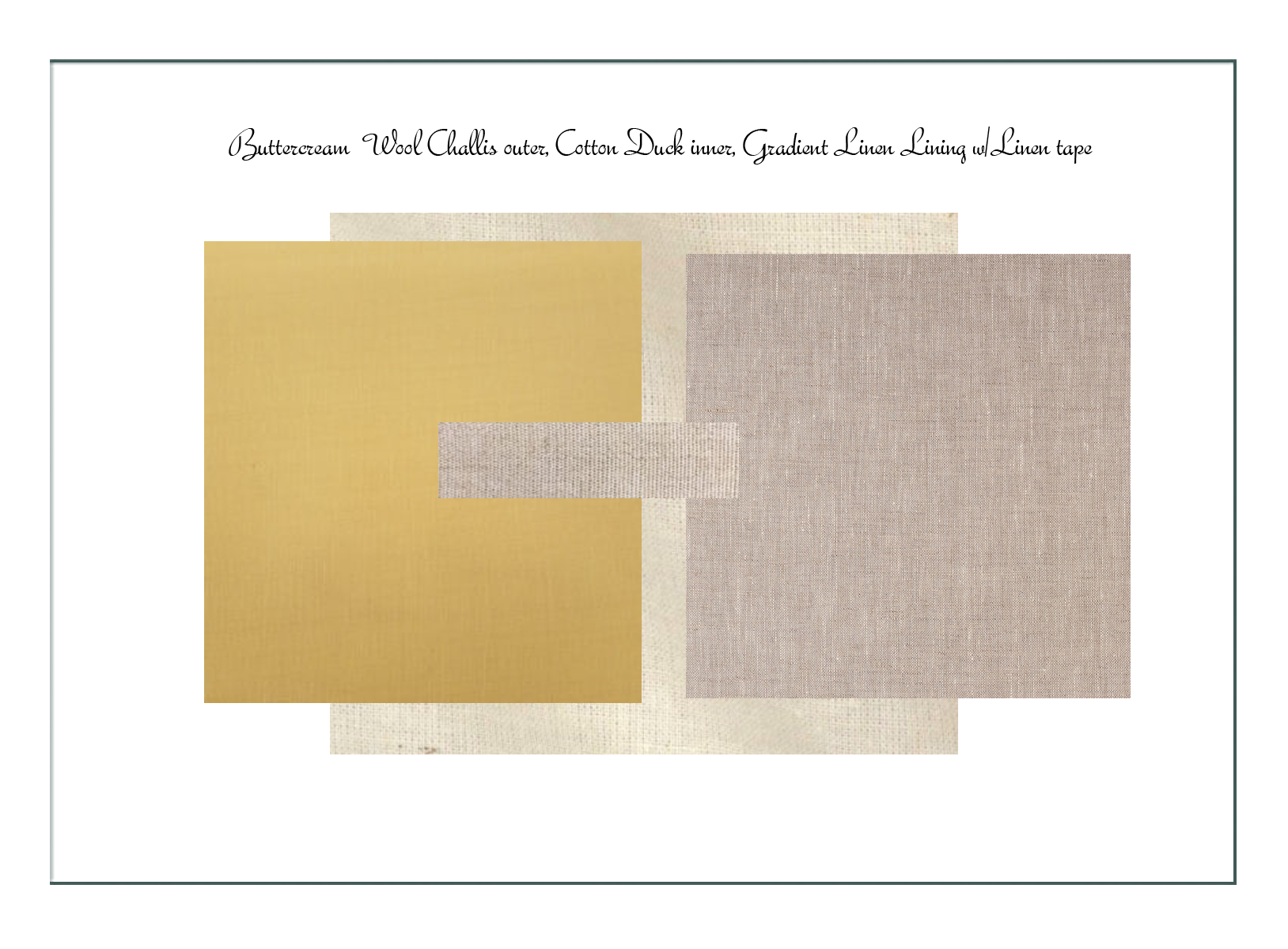
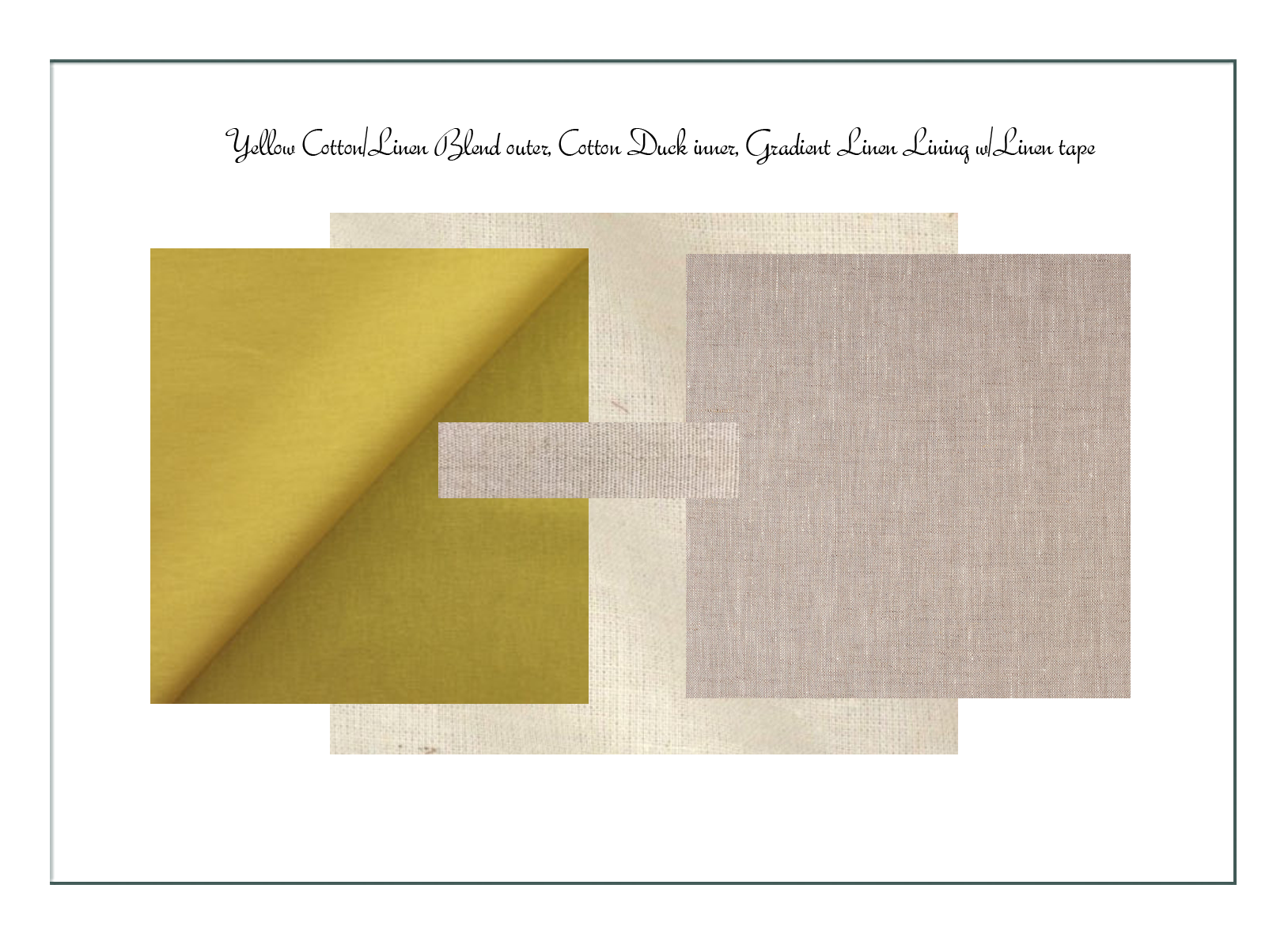
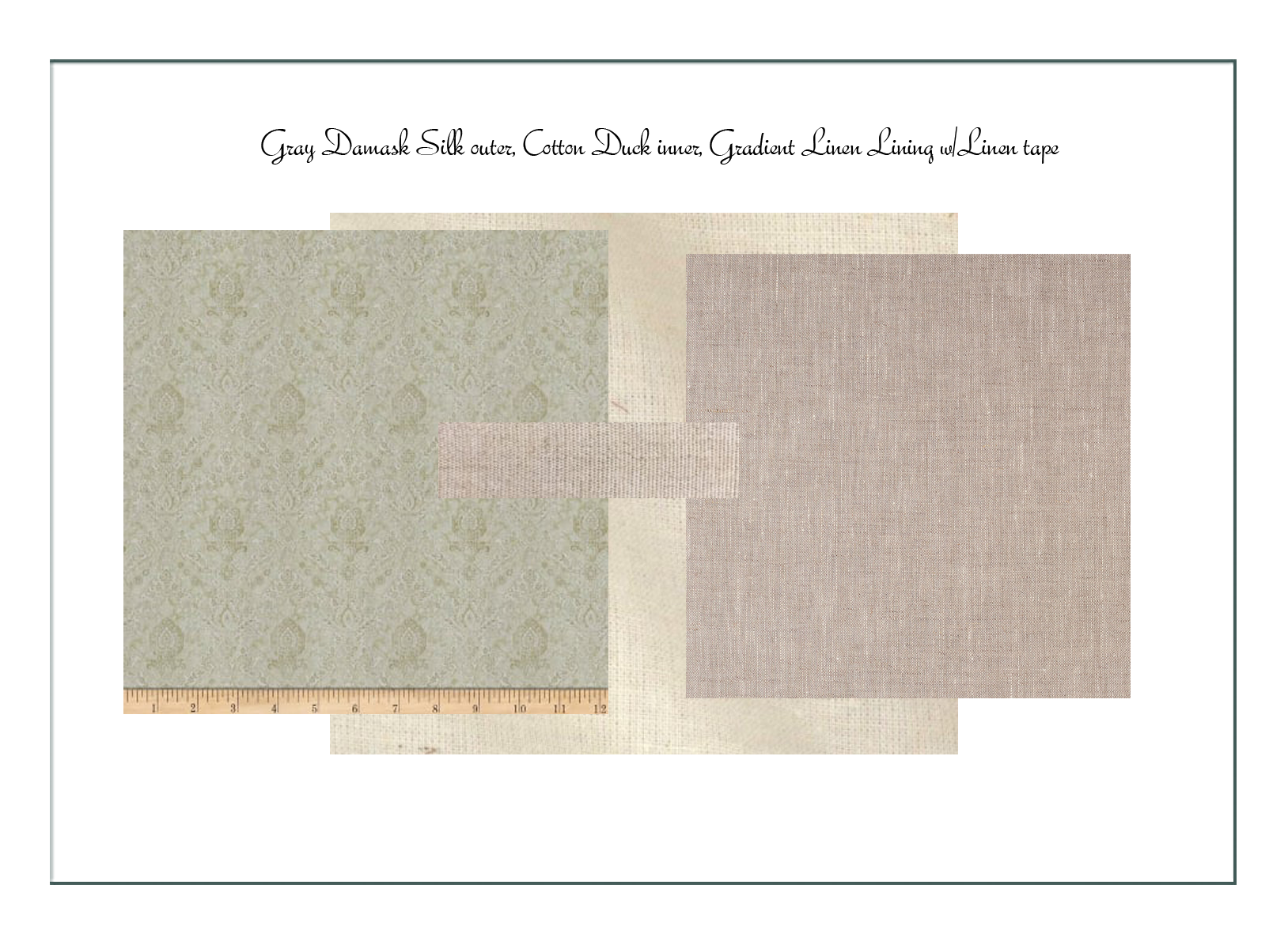
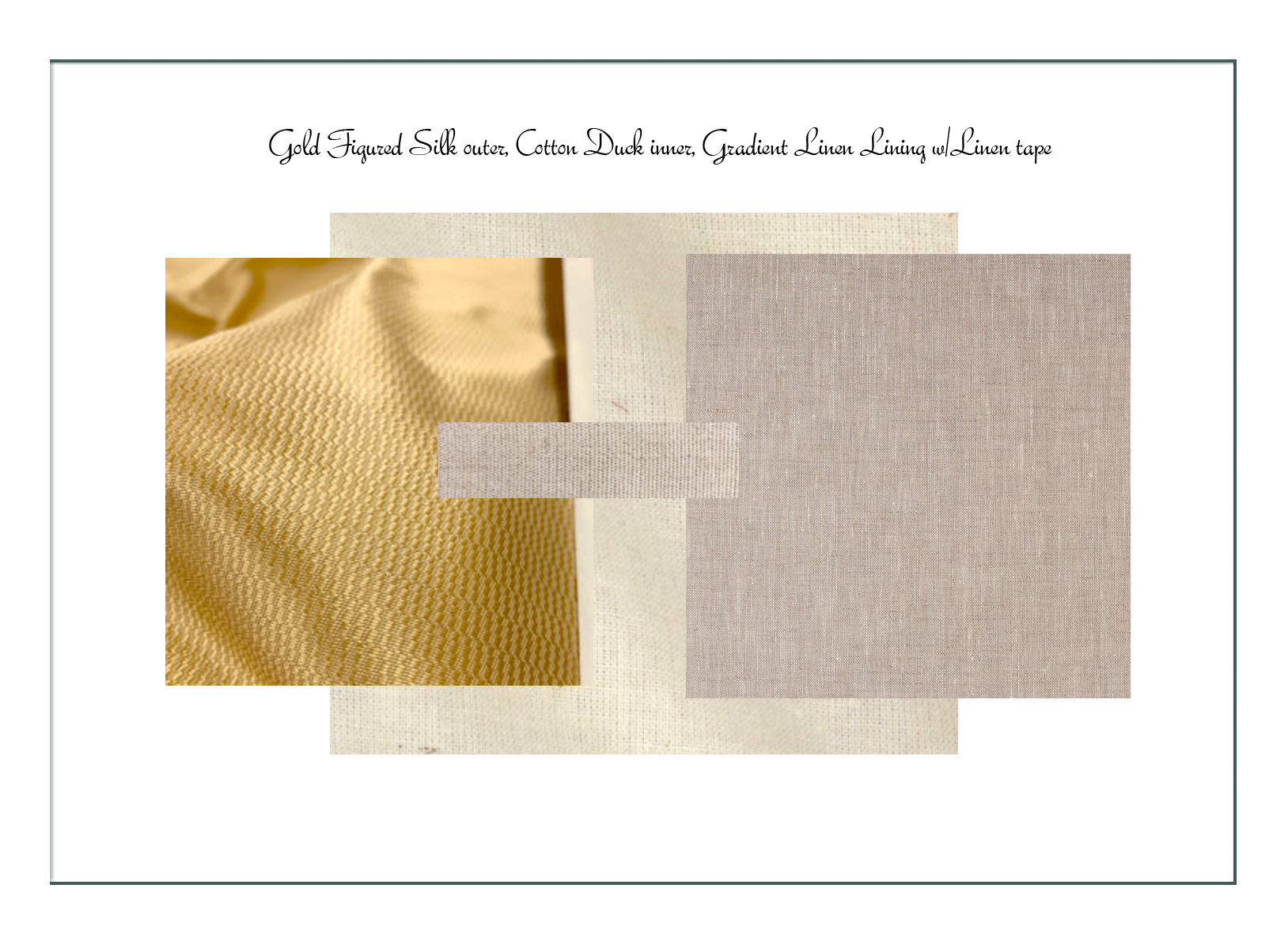
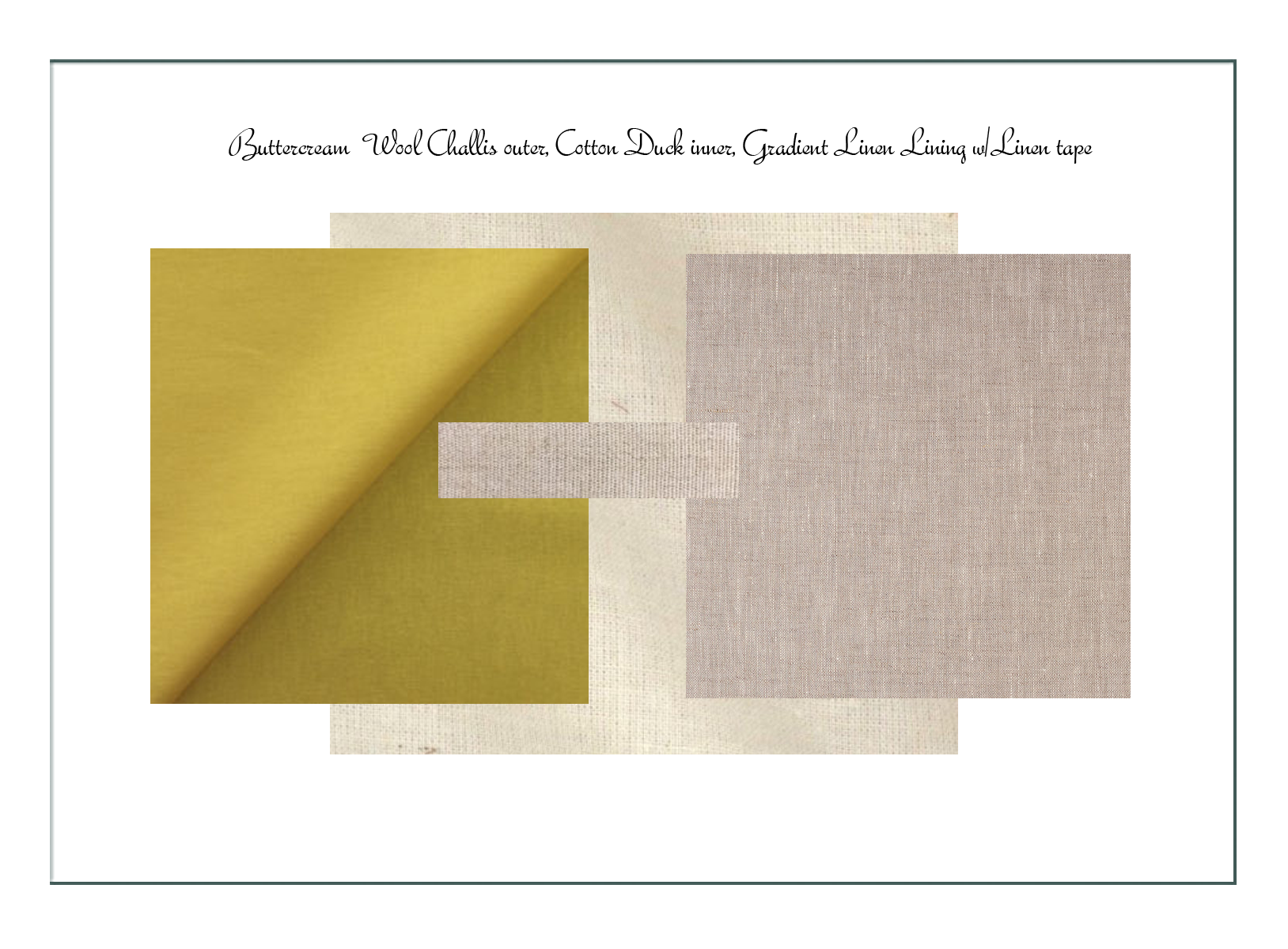
For Robe/Bodice/Skirt
(Linen and Chintz)
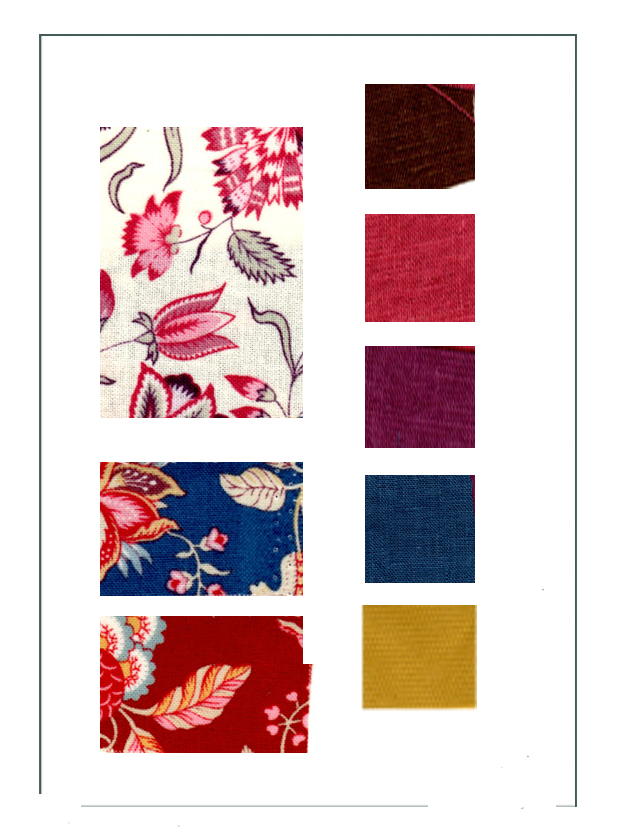
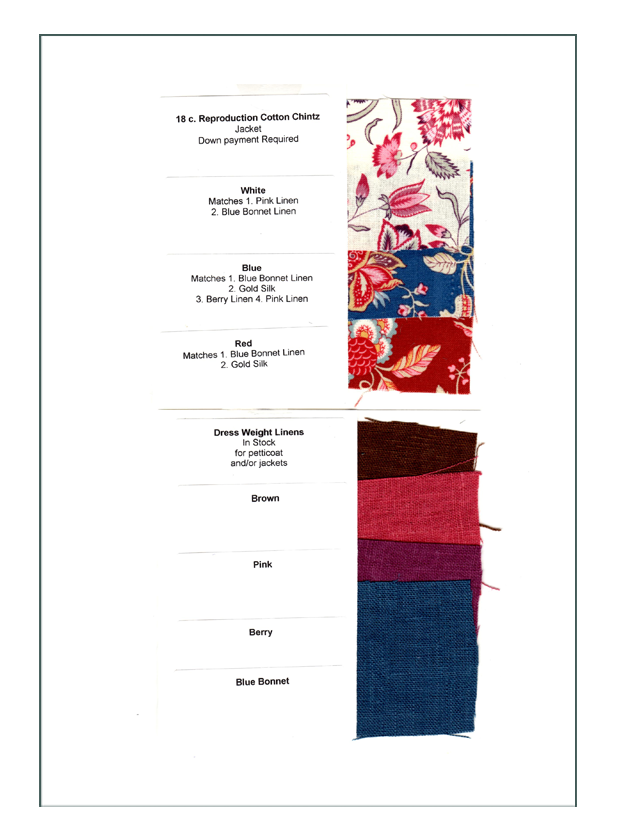
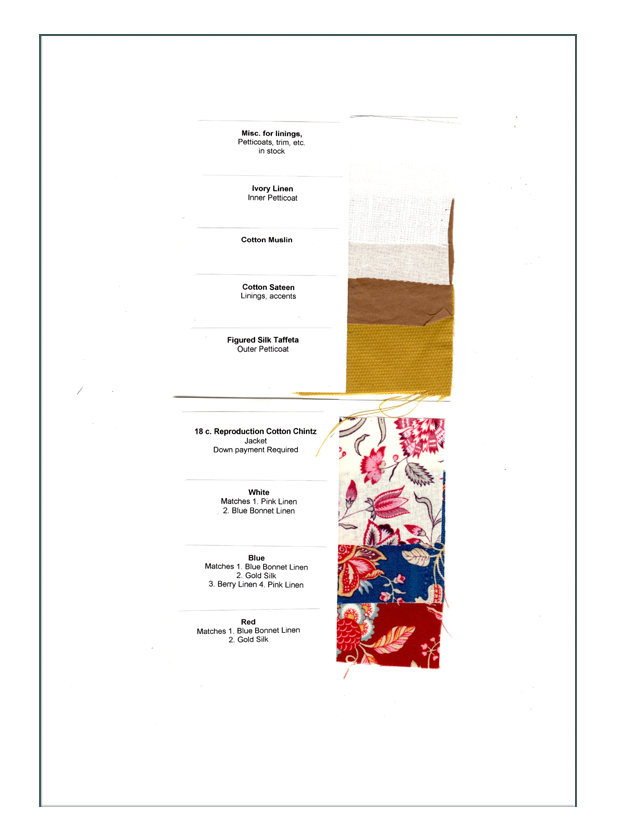
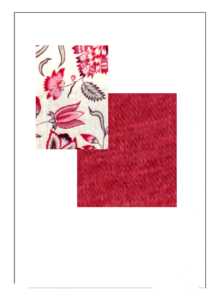
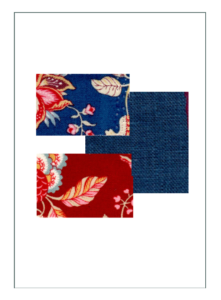
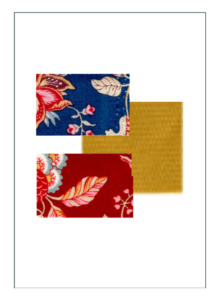
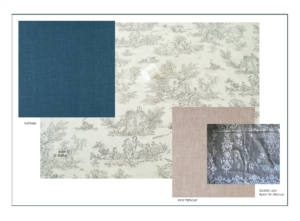
For Bodice, Skirt, Robe, and Apron
(Wool & Homespun)
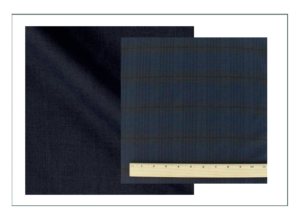
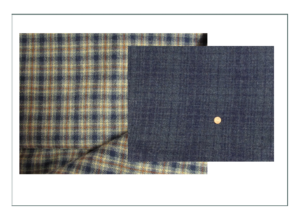
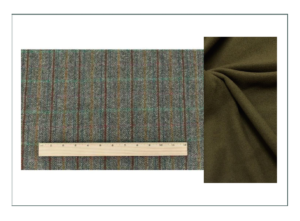
For Robe, Bodice, Skirt & Stomacher
(Wool & Crewel)
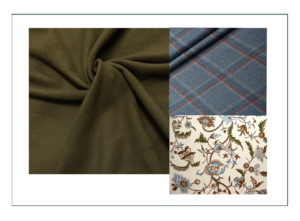

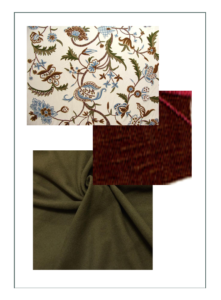

Combinations for all Garments Together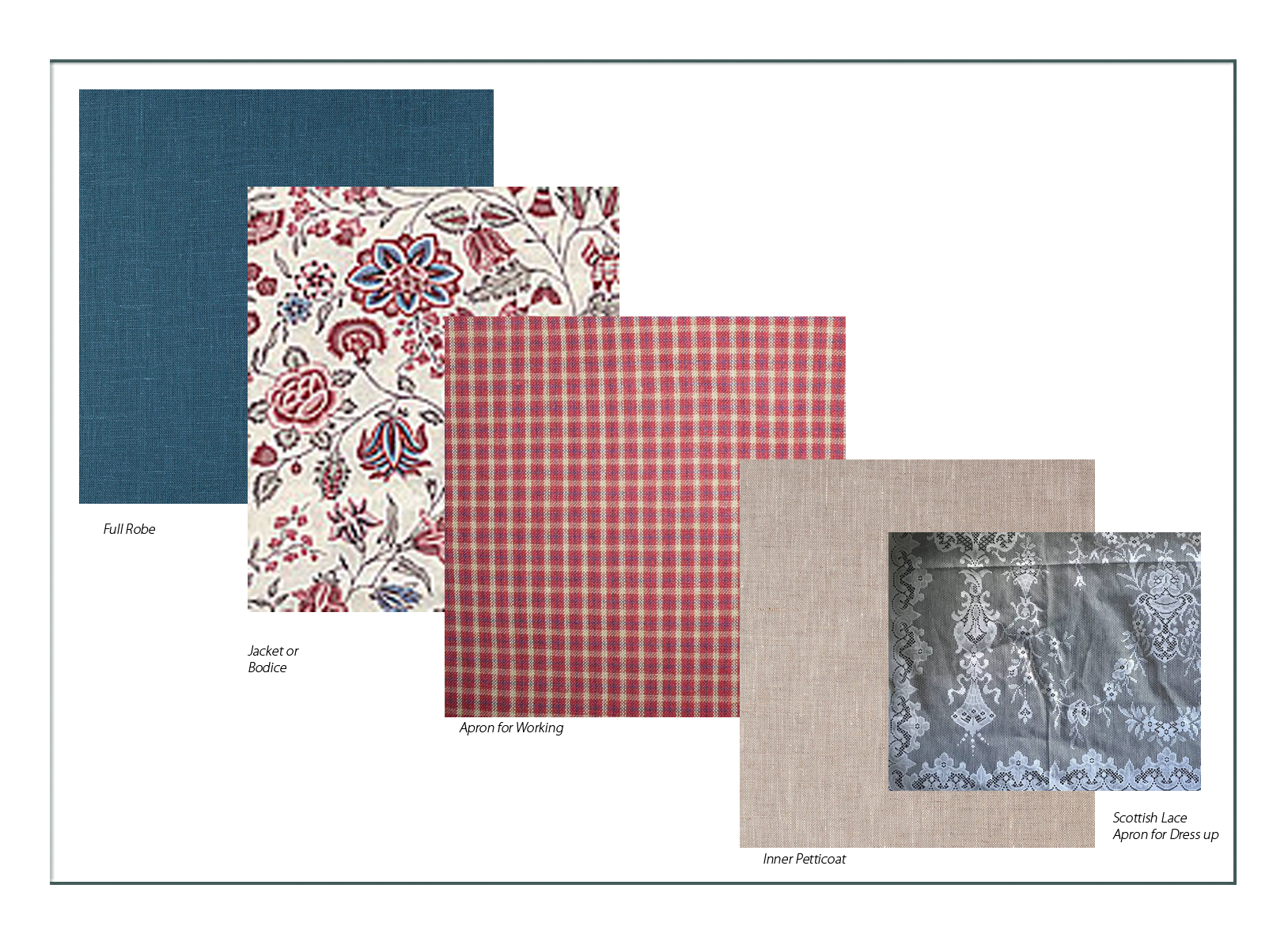
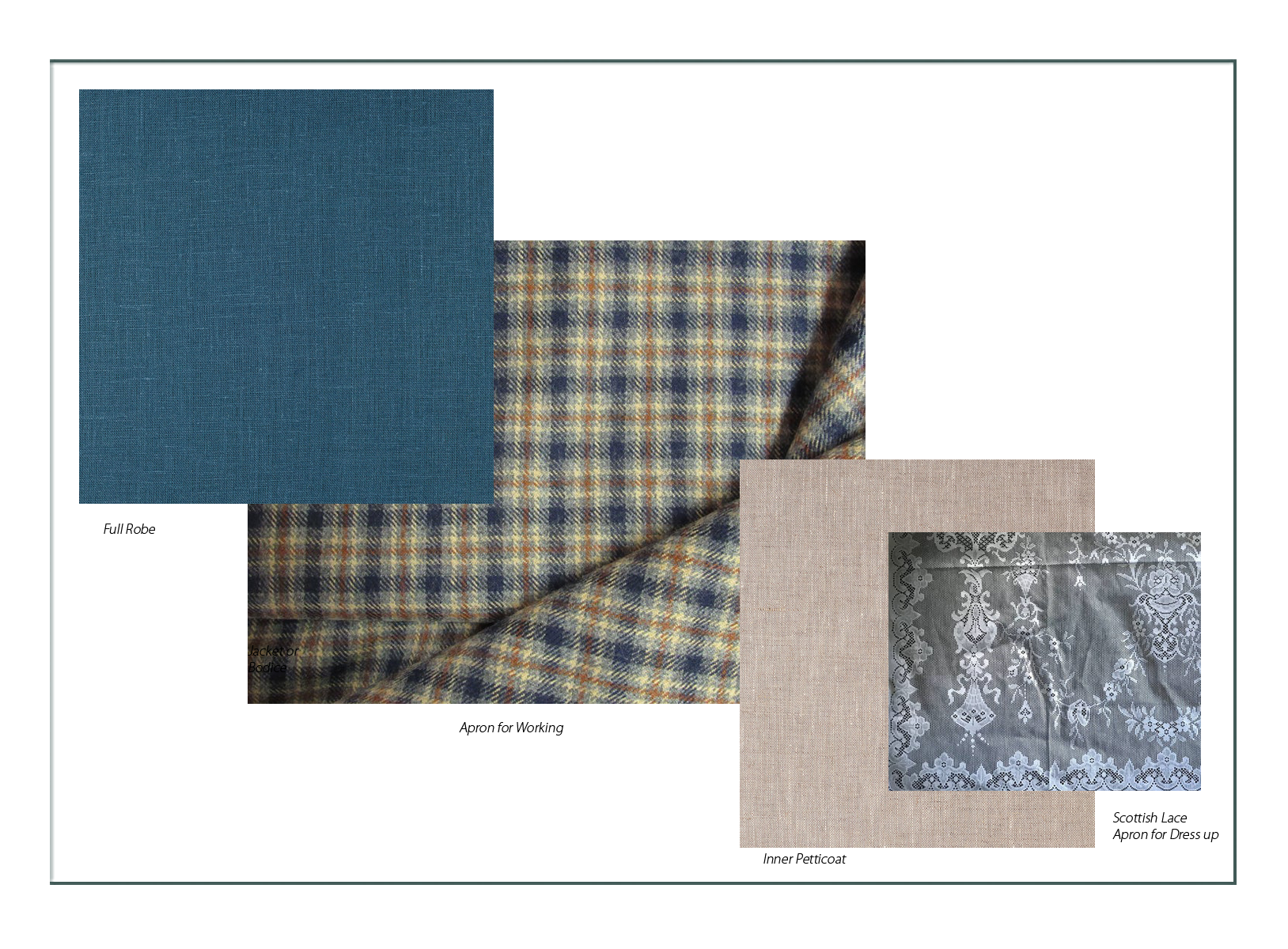
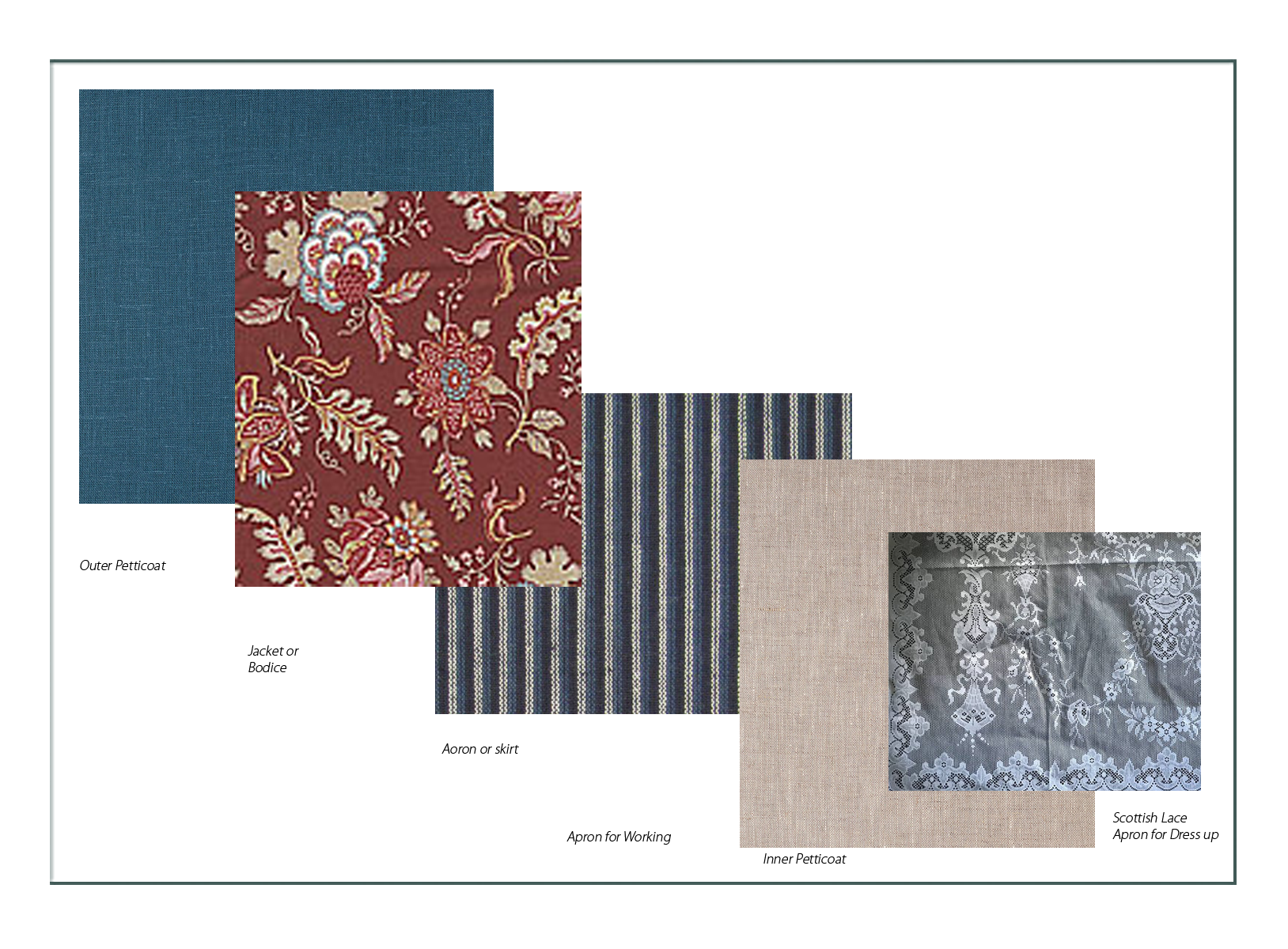
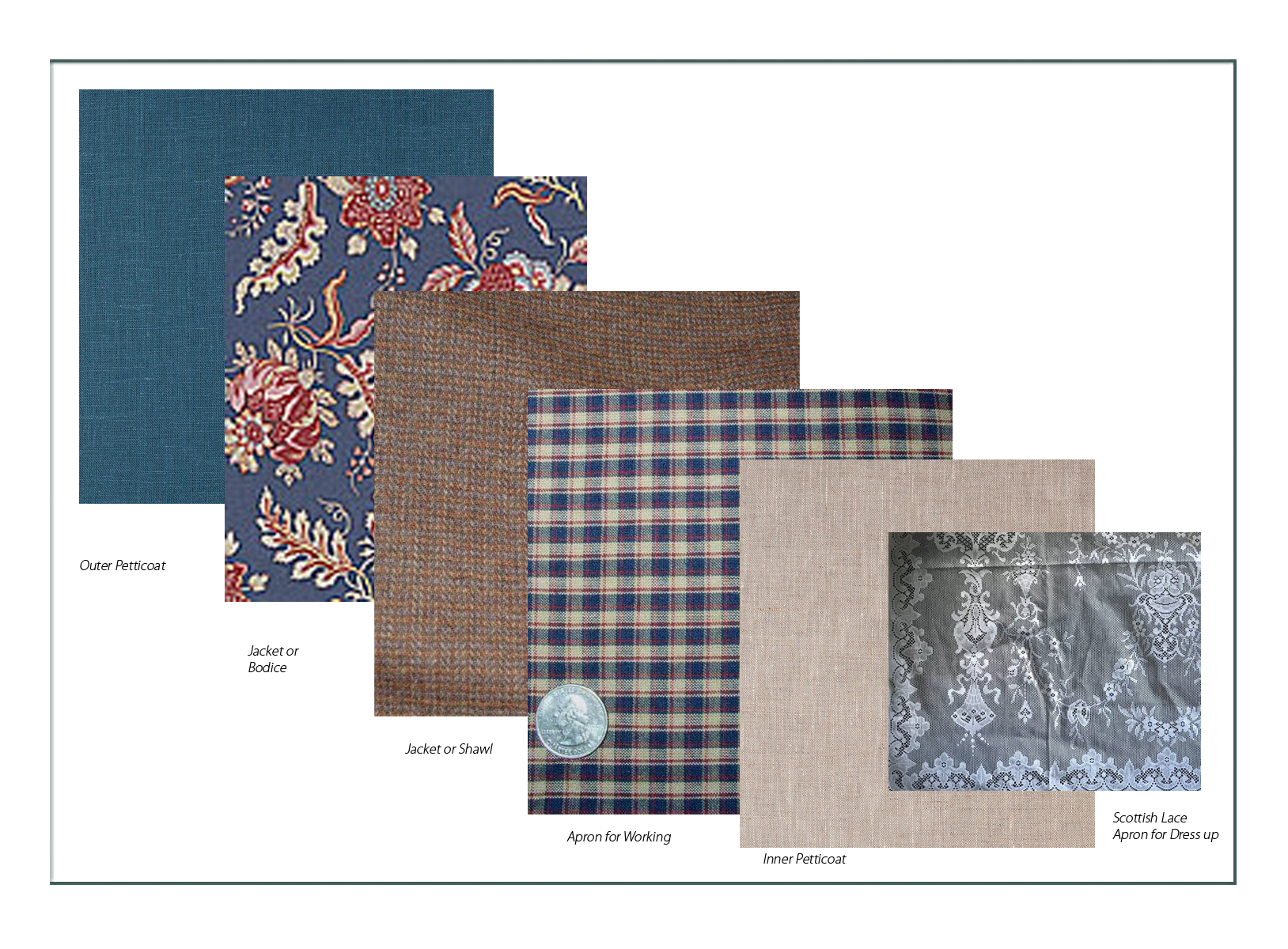
 Narrowing down choices after meeting with Susan
Narrowing down choices after meeting with Susan
Susan has done lots of research and thinking on her own, and came into our first design meeting with great ideas. The first thing she said is “Let’s do 1745”, to which Suzi responded “Wait! I think we can do it all.”
While we talked in depth about which styles were consistent to the entire 1745-75 timeframe of depiction, we focused on a few key concepts:
- Ideas, tastes, culture, history, or items a Scottish woman of 1745 might take with her to the Colonies (How much “Scot” she wants to portray now, and how much her character would have in her new home)
- Class and social status of her character and how that affects the overall look and specifics such as fabrics, textures, colors
- Specific construction including comfort and wearability for her real events (such as sleeves, bodice, skirt, stays) – such as which fabrics will suit both north and south events, way the bodice closes, how things are laced, stomachers and how they are attached, etc.
- Availability of materials with cost (keep the cost down!)
We talked at length about front bodice closures and lacing, for ease in her dressing herself plus historical accuracy:
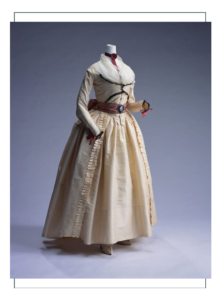
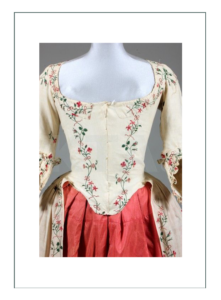
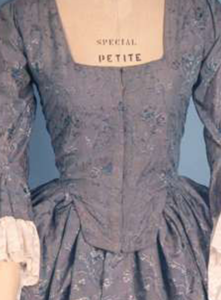
We strayed a bit to discuss women’s sanitary processes while talking about whether or not modern underwear is acceptable with this ensemble (panties yes! bras and girdles no!)
Most interestingly to Suzi was Susan’s introducing the concept of today’s fashion trend being to wear historical garments as “Making Historic Dress Modern”, in which people are modifying and wearing historical ensembles or pieces to work and out in public. She has a great idea to wear some version of her ensemble to work at a hospital (office), and/or to show her King Charles Spaniels which she raises professionally.
This is intriguing and great to know young people are really studying history in detail!
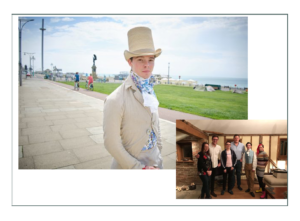
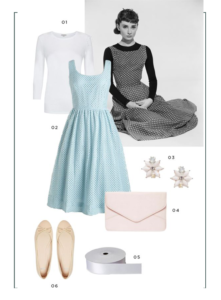
Susan made other clarifications:
- Needs breathable cool fabrics, and ensemble as whole needs to be comfortable (she lives in the far south), she;
- Wants to wear any/all as much as possible to modern events too. Key historical events she participates in where she could potentially wear this: “Outlander Tea” in Arizona once a year (where Diana Gibaldon comes!), Celtic gathering in Flagstaff once a year (tiny), and Celtic games in North Dakota once a year in October. (Suzi suggested she find some opportunities to teach about herbs or herbalists, or Scots, in the community);
- Has purchased an ornately embroidered stomacher which needs to be integrated into a bodice (will send photo); same designer in Germany can make a custom one if we need;
- Has purchased embroidered pockets (worn under the petticoat, only way that affects what we are doing is we need to be sure the slits are correct on both outer and inner petticoats);
- Will dress herself, and needs to be able to do so quickly and efficiently;
- Is 4th generation Scottish of the McKay Clan (which Anglocized the name after they came in the 2nd Great Migration to the St. Louis area in the 1880’s to McKey pronounced ‘Mack’ ee’). Her mother is a McKay (McKey) and through the family, especially the girls, the heritage is passed keeping the family name as middle name. Her mother was the youngest of 12 children.
- Likes the idea of lots of pockets full of vials, etc. We might be able to hide some for her!
- Her Clan plaid is the McKay (red, black, teal/blue), but she has purchased one called “Honor and Redemption” (will send photo) from which another party will be making a petticoat. Suzi forgot to ask if she had enough for an airisaid, but assumes not.
- Her family throughout history was mostly Presbyterian – just like the ones we studied
Susan’s preferences in design, color, shape:
- Stay closer to the 1745 Scots than the 1775 Colonists (Suzi adds – we can do both!)
- Steer clear of the rough working fabrics, colors, and textures with loose fit of working class and Scots; no outer garments of yellow, green, or brown. Likes the pinks, blues, teals, whites of samples sent. MIGHT accept yellow undergarments or naturals.
- Has had recommended to her a “Melton” wool for a bodice, which is actually a type of twill woven. It is a very thick wool with nap that has been sheared short, similar to “MacKinaw Cloth”. It is very solid, solid in scolor, and is hard wearing and weather proof. It is used mostly on outer garments like cloaks and blankets. It is used for undercollars of jackets. The English wore red scarlet Melton coats while fox hunting, so the fabric became a symbol of upper class elites in England, but other colors were workwear
- Adds historically – she might have gone to France instead of the Colonies in 1745
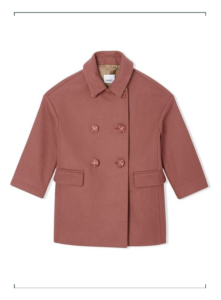
Suzi suggests:
- Let’s stick with the storyline going to the Colonies, although both Outlander and real Scotch history means it would be entirely feasible she would have gone to France first in the 1750’s-’60’s. If that was so, we need another entire discussion on application of fashion, especially if she lived in or near a town where she would have keen high fashion influence, rather than the somewhat “watered down” version of fashion as interpreted in Scotland and then another skip to the Colonies with it’s “function first” attitude.
- Design undergarments consistent throughout era
- Must have mobcap; the smaller round-eared type that’s not extreme and keep the cost of it down but be historically accurate
- Focus on natural colors and especially Scot’s favorites they brought with them including the textiles: weaves, tweeds, argyles, plaids, (twills like the Melton she mentions). Browns and yellows were the favorites.
- Let us build this (sketches to follow):
- shift (has already)
- stays (recommend berry linen or buttercream yellow wool with natural linen binding)
- stockings & shoes (she has from American Duchess)
- inner petticoat (gradient linen – the gray green of working classes for underneath)
- outer petticoat (blue bonnet by us; a 2nd one of the “Honor and Redemption” plaid by others)
- bodice with crossover and pinned closure in front (version as per example below, consistent with mid-way between ’45 and ’75, fitted, caracao not shortgown – with inset sleeves), possibly with the folded/rolled sleeve of the shortgown. This is a plain fabric such as a matching blue bonnet linen so it can be worn as a single color ensemble for modern use –
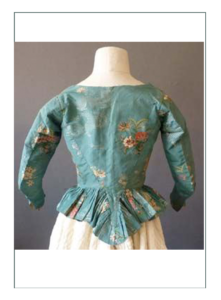
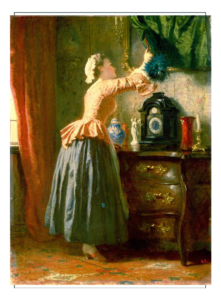
OR
- Solid color bodice with ornate pinned stomacher. She might need two bodices in which case we can make the floral (Suzi recommends the matching blue instead of the red because of modern use) jacket closed in the front – AND – a wool bodice that ties front in a looser fit of a Scottish type weave (such as the Melton.. or a Tweed). That could go over the stomacher too, although not for low class depictions.
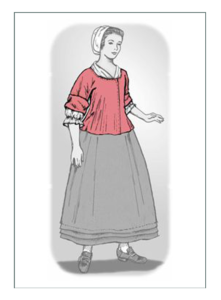
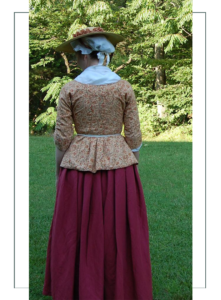

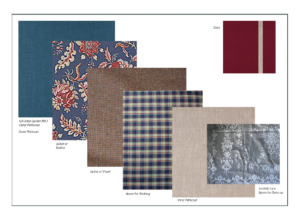
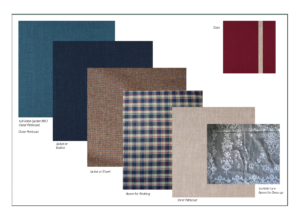
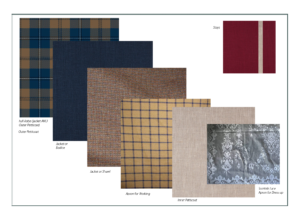
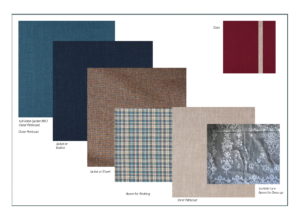
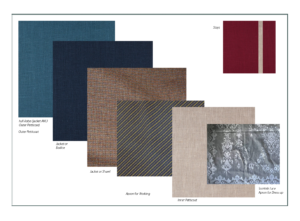
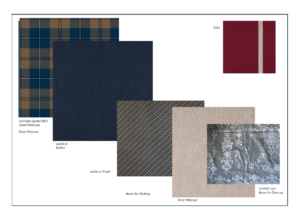
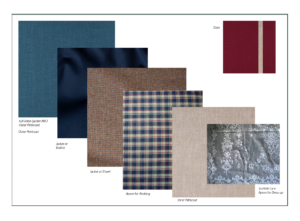
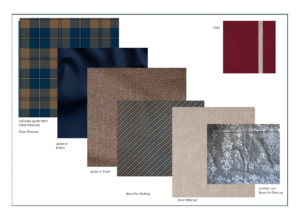
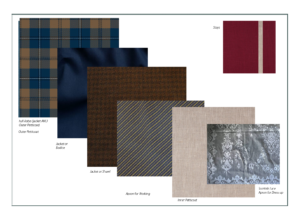
Decision by Susan: No lace
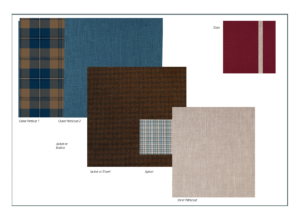
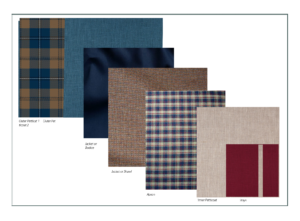
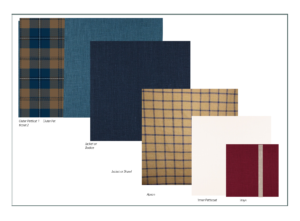
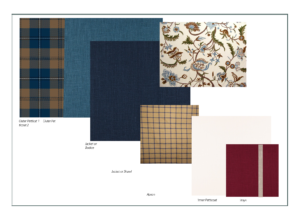
DESIGNER FAVORITES
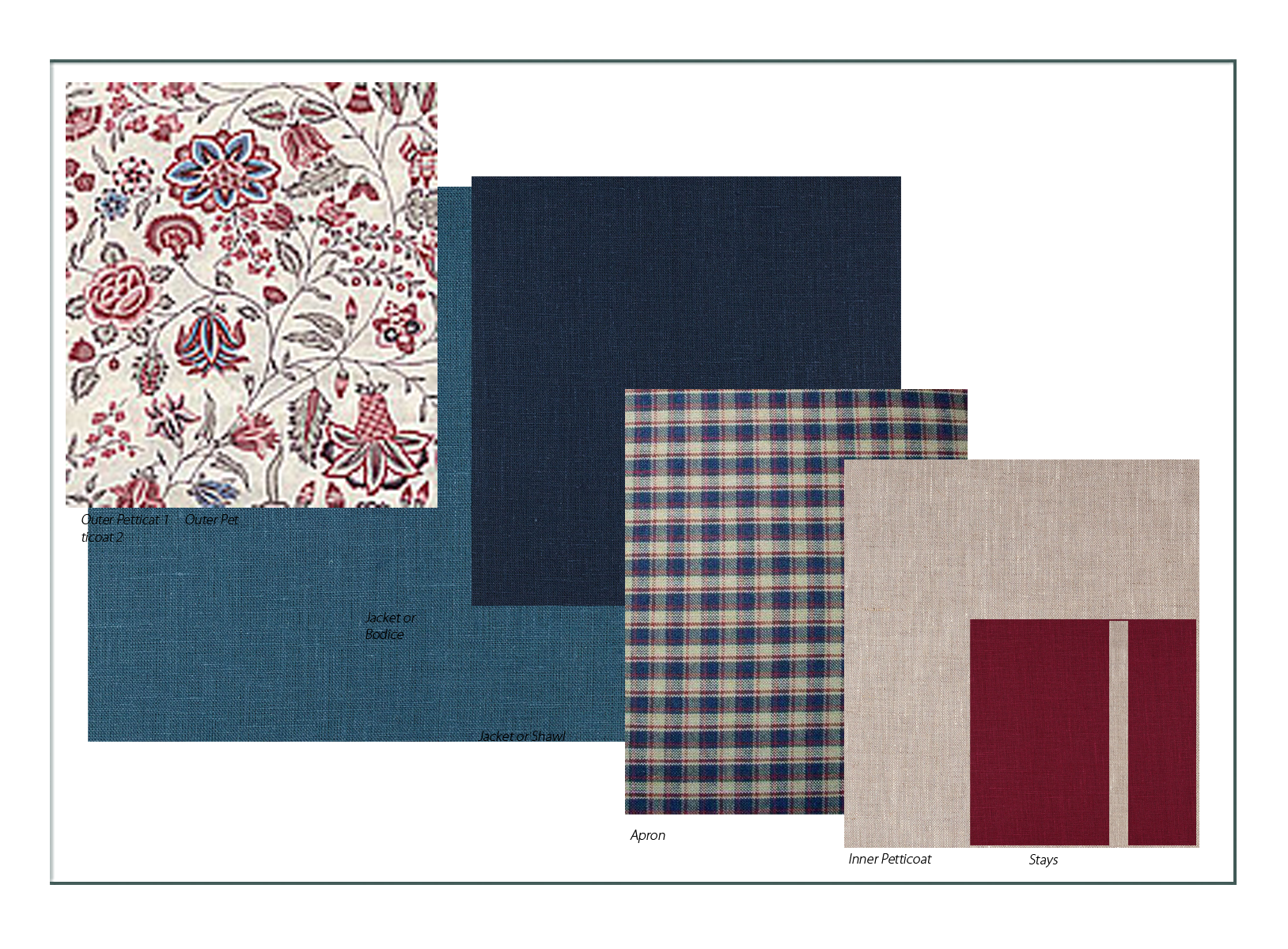
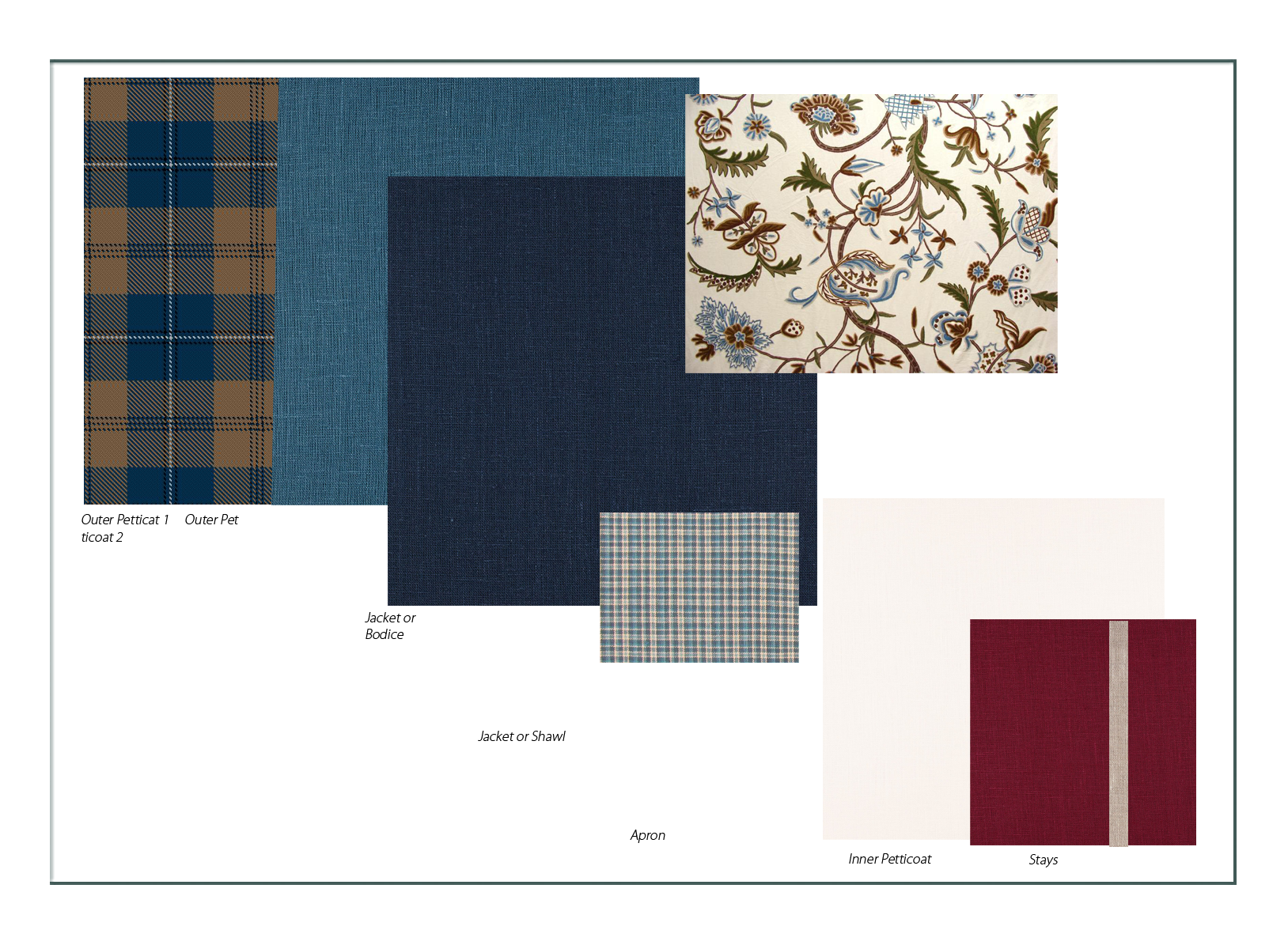
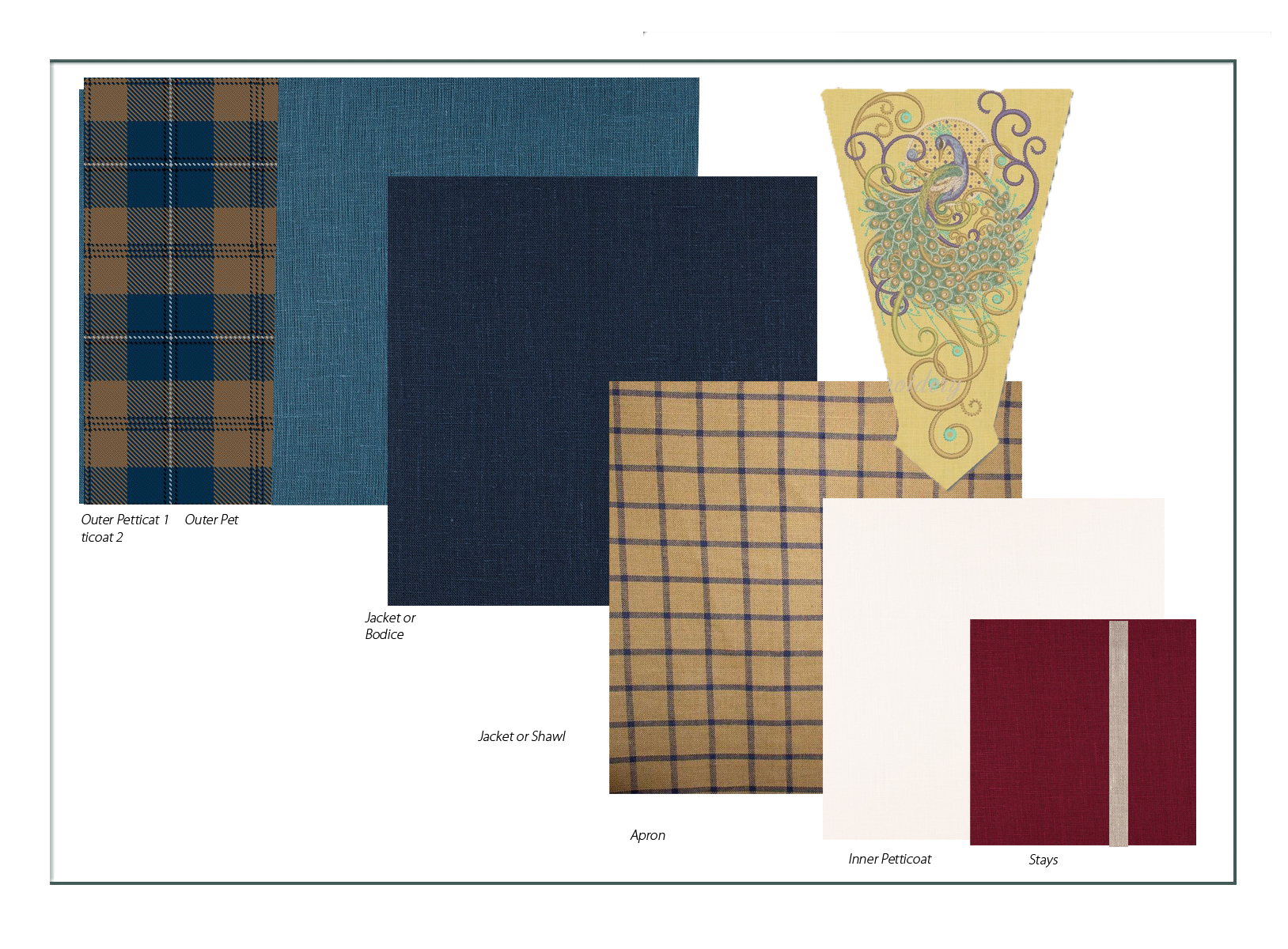
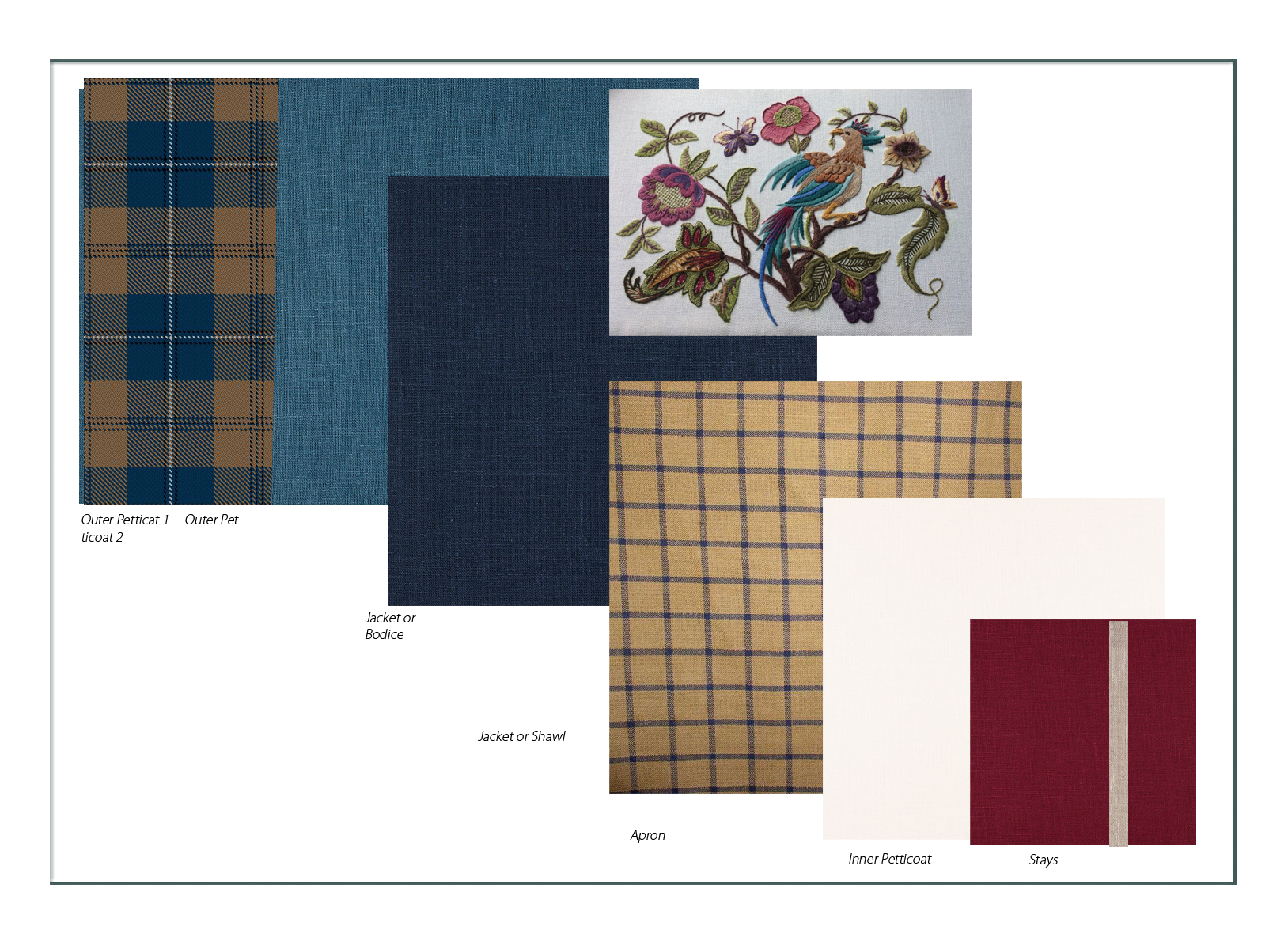
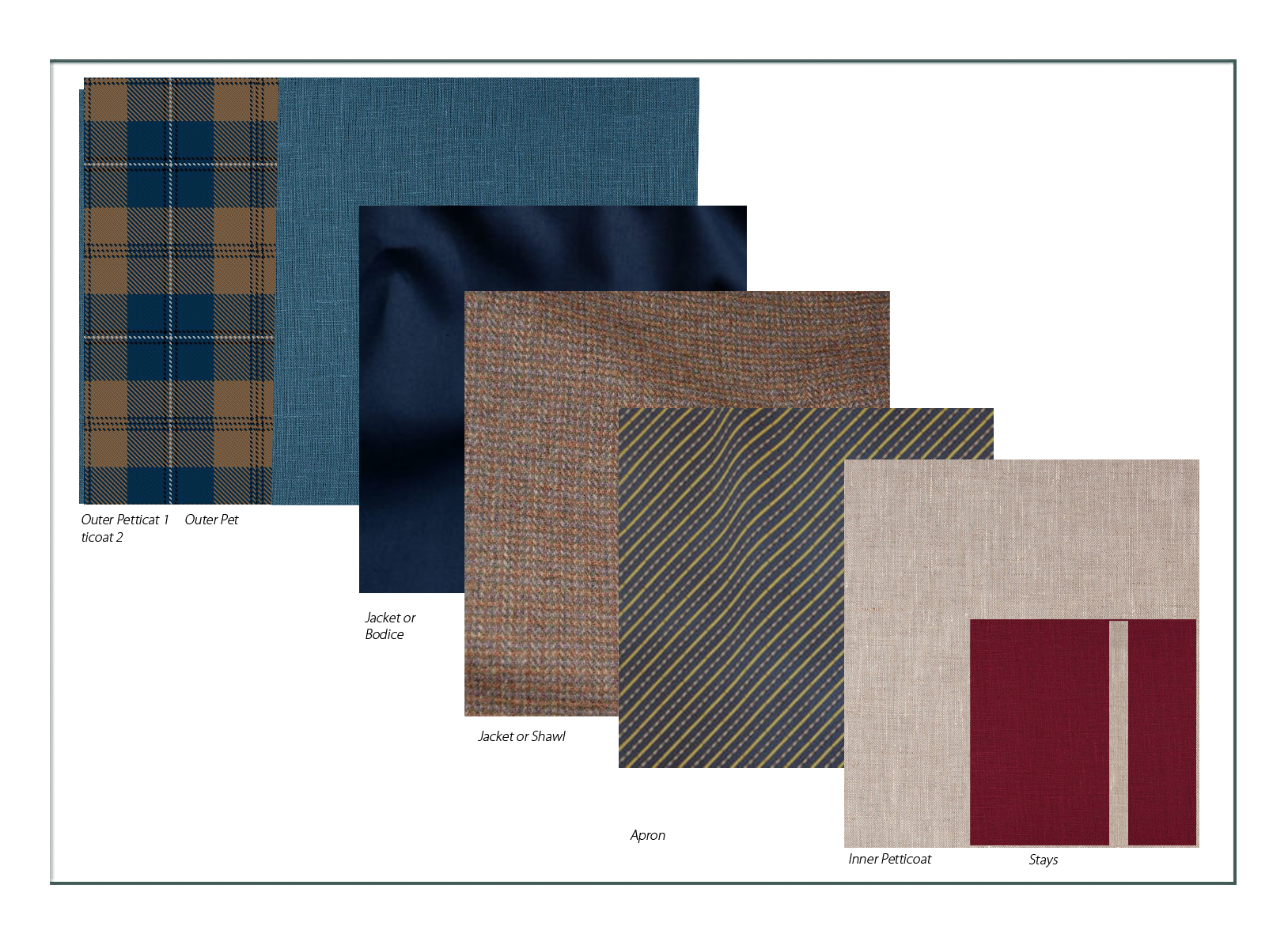
FINAL SELECTIONS after discussion with Susan & Pending fabric samples:
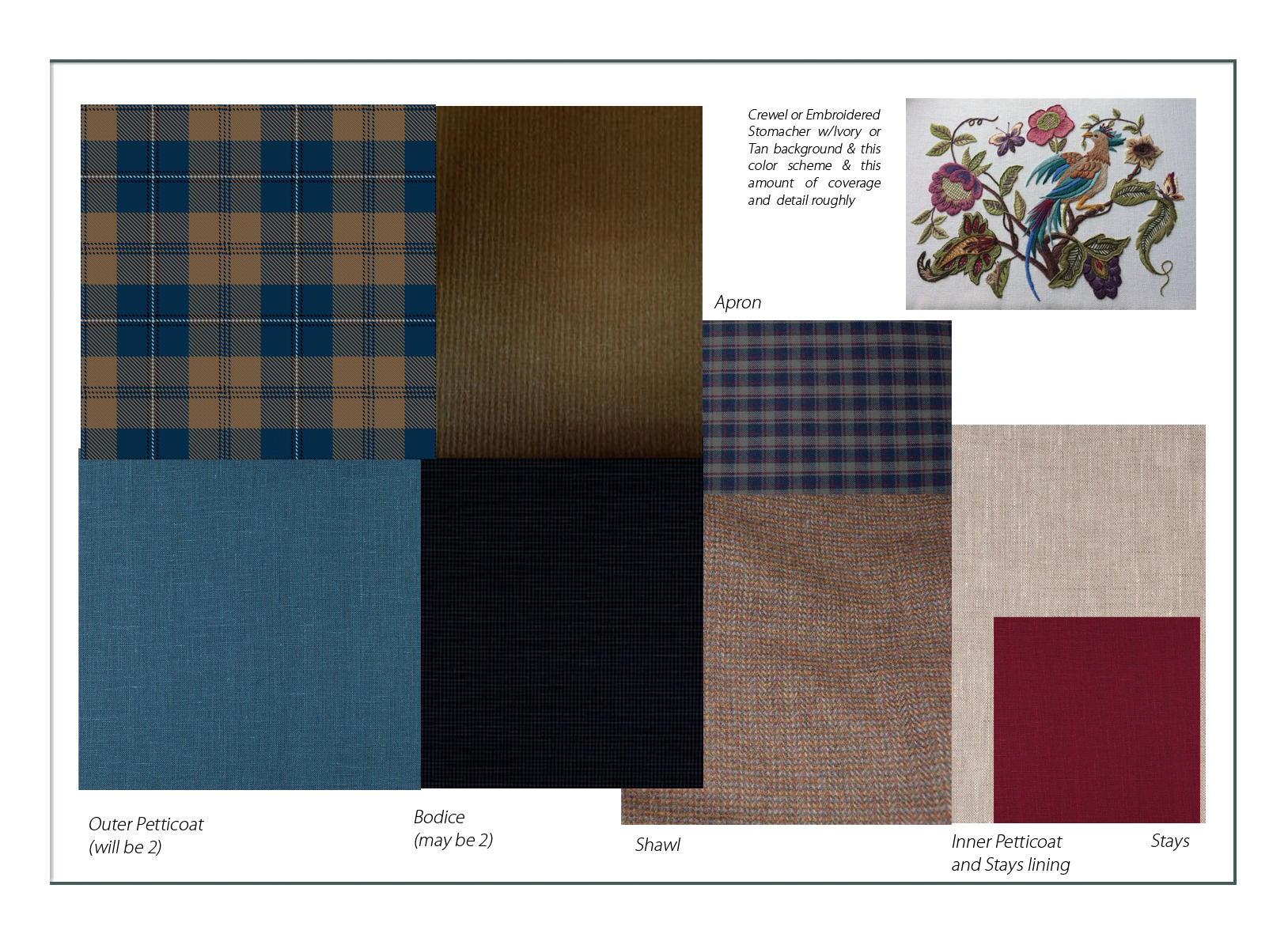
She will have
- 2 outer petticoats, a Tartan & Blue Linen
- 1 dark blue wool pique bodice with ivory or tan background on crewel stomacher (caraco)
- Optional 2nd tan wool bodice of looser design (shortgown)
- Apron of homespun coordinate (no lace)
- Optional shawl of woven brown/tan wool
- Inner petticoat of gradient (brown/gray) linen
- Stays of linen berry pink with gradent linen binding and lining
- (already has cotton shift with arm ruffles)
- Mobcap of ivory handkerchief linen
- Has stockings and shoes (can supply woolen stockings gray, brown, ivory)
- Optional knit gauntlets and cape (by customer?)

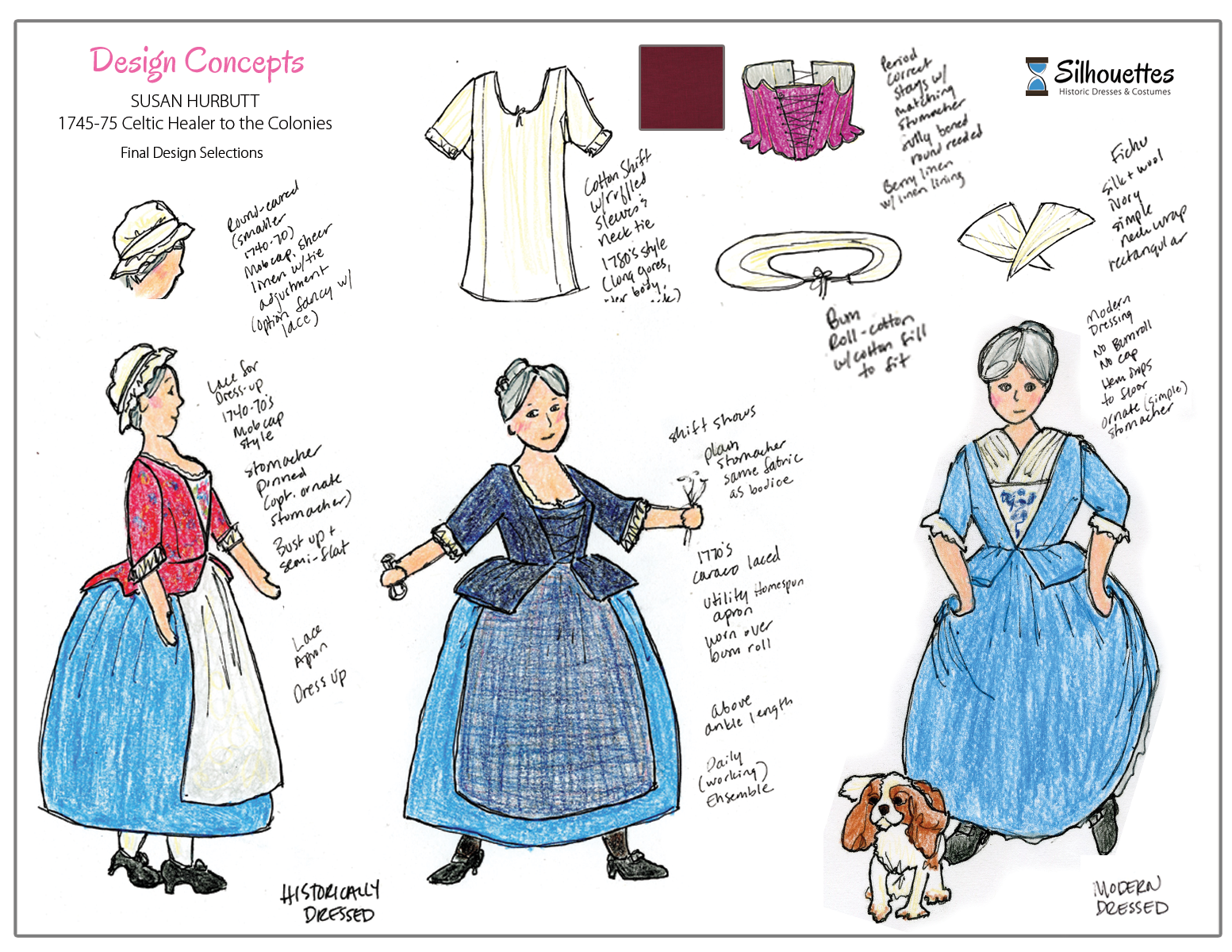
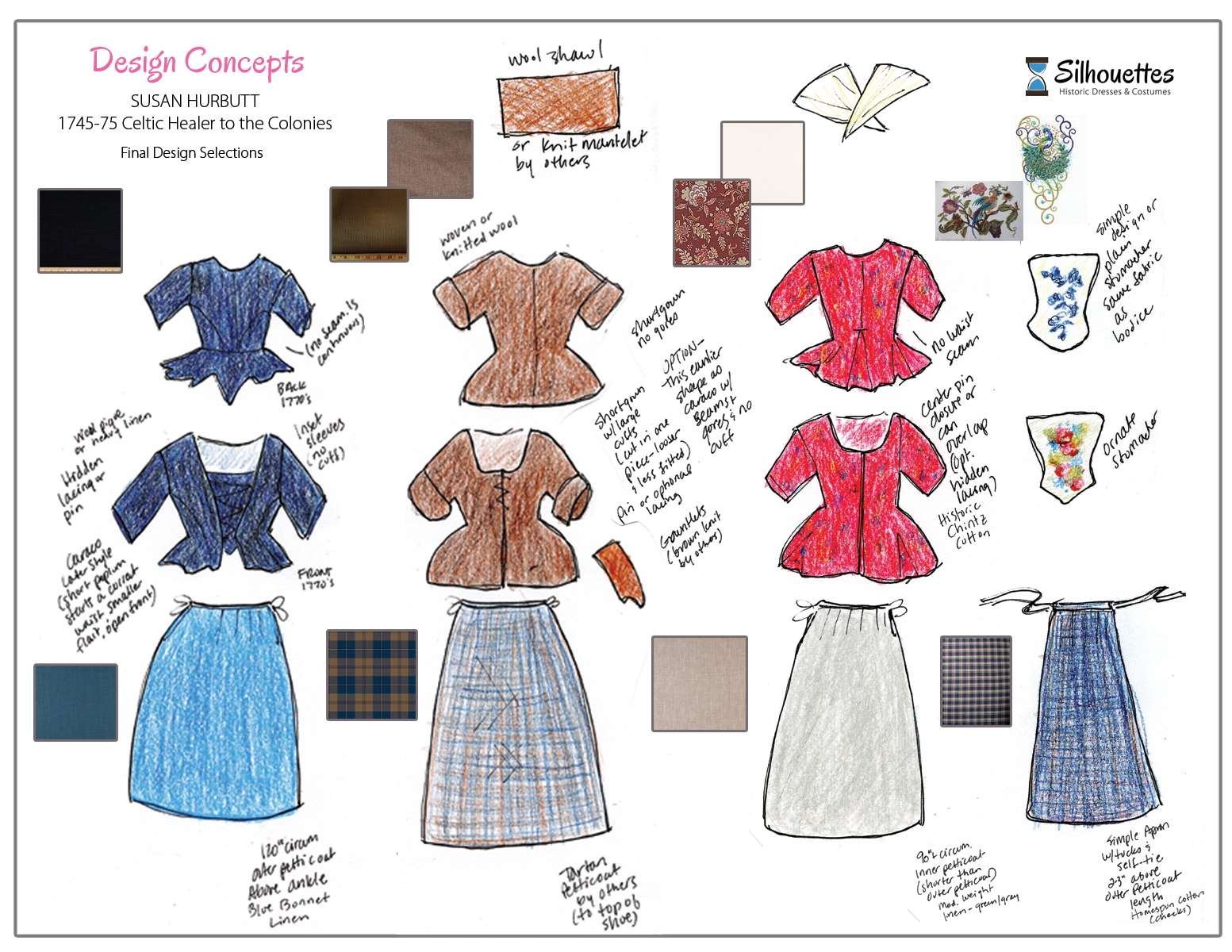
Mix & Match – coordinated ensemble that works for 1740’s Rural Scotland, 1770’s Colonial Healer, AND Modern wear at dog shows!
1740’s:
Brown woven wool (two weave options) shortgown (jacket) worn with “Honour & Redemption” Tartan or Blue Bonnet linen outer petticoat (no stomacher);
Midnight blue pique wool 1740-70’s fitted bodice with peplum with same petticoats with any stomacher or matching (same fabric) stomacher;
Blue Bonnet linen bodice same fabric as petticoat (any era design) with blue bonnet petticoat with navy blue and white stomacher;
Reproduction red floral cotton chintz caraco with blue bonnet & ornate stomacher.
SAME FOR ALL:
“Gradient” 100% linen (gray/brown rural and rustic looking) inner petticoat;
1740-70 stays made of 100% linen (berry color with gradient/natural linen binding);
Reproduction leather shoes & cotton stockings (by others);
Shift (already has; 100% linen available);
Bum roll custom cotton correct for 1740-70’s;
Mobcap all hand made 100% linen correct for 1740-70’s (smaller type with no ornament and simple ruffle);
Apron of dark blue with tan and red checked cotton homespun (with option for lace apron made of Scottish lace with chintz option);
Optional brown woolen shawl, gauntlets, mantelet knit (by others?), and additional stomachers.
She has already her own:



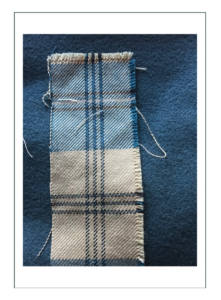

After discussion with Susan including pricing and options. She has decided to do one thing at a time starting with shift (has already), and stays. There will eventually be several bodices, but the project will be done in stages.
PROJECT 1
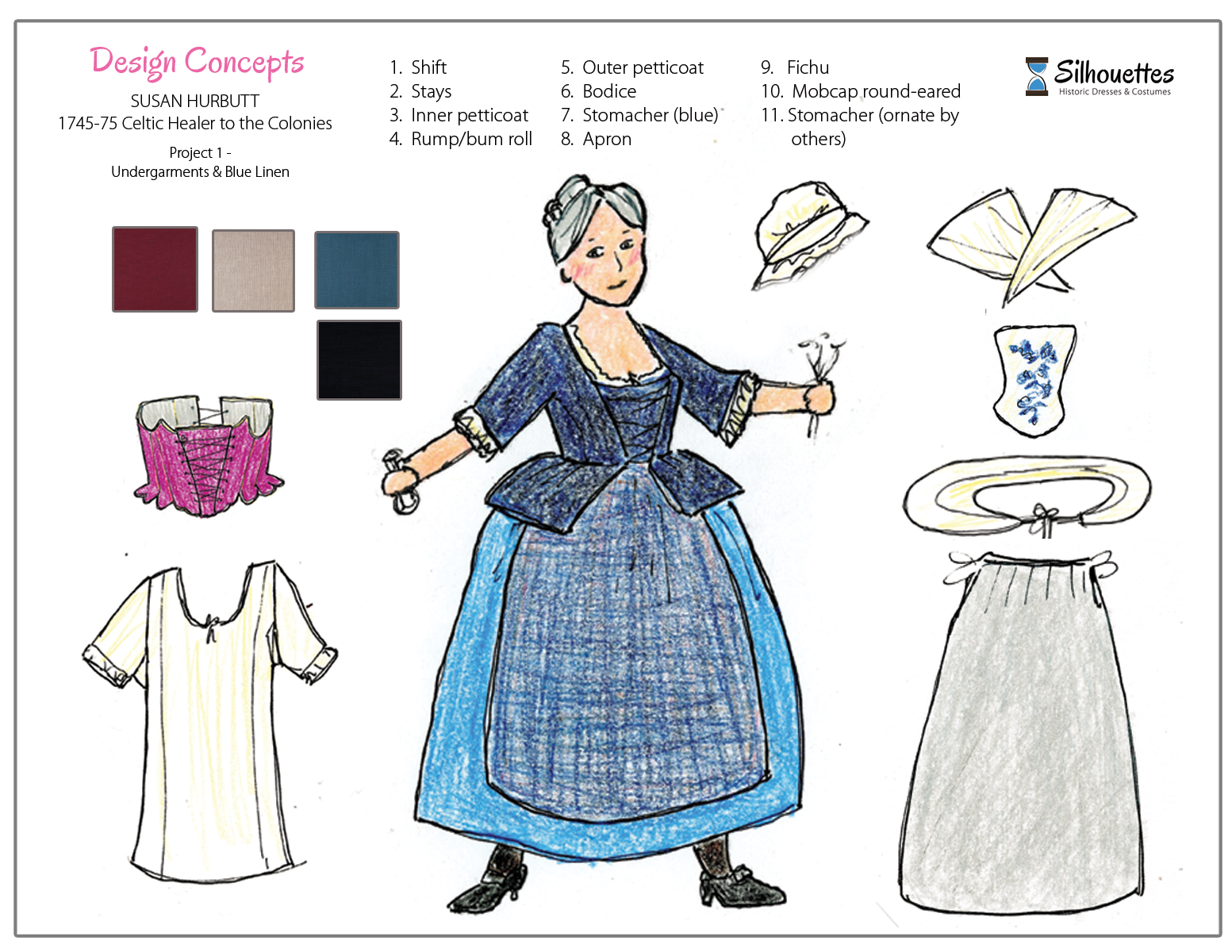

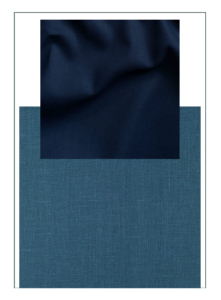
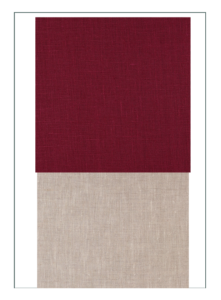
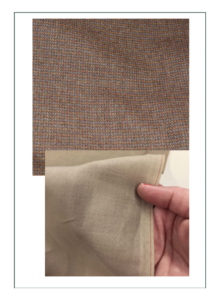
Click here to go to Susan’s Main Page with the Finished Project (next)
Click here to go to Susan’s Historical Context Page
Click here to go to Susan’s Fashion History Page
Click here to go back to the top of this page
